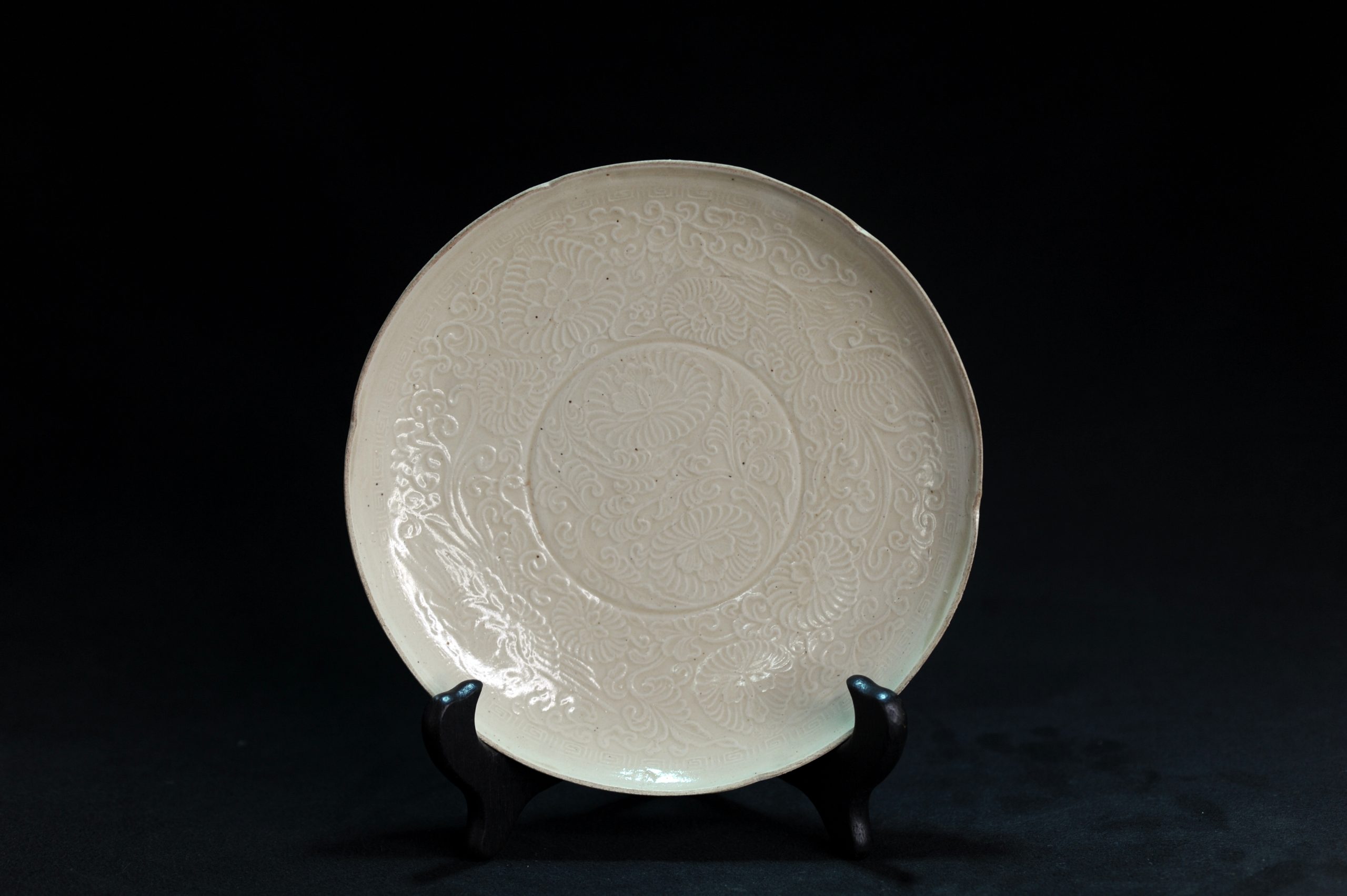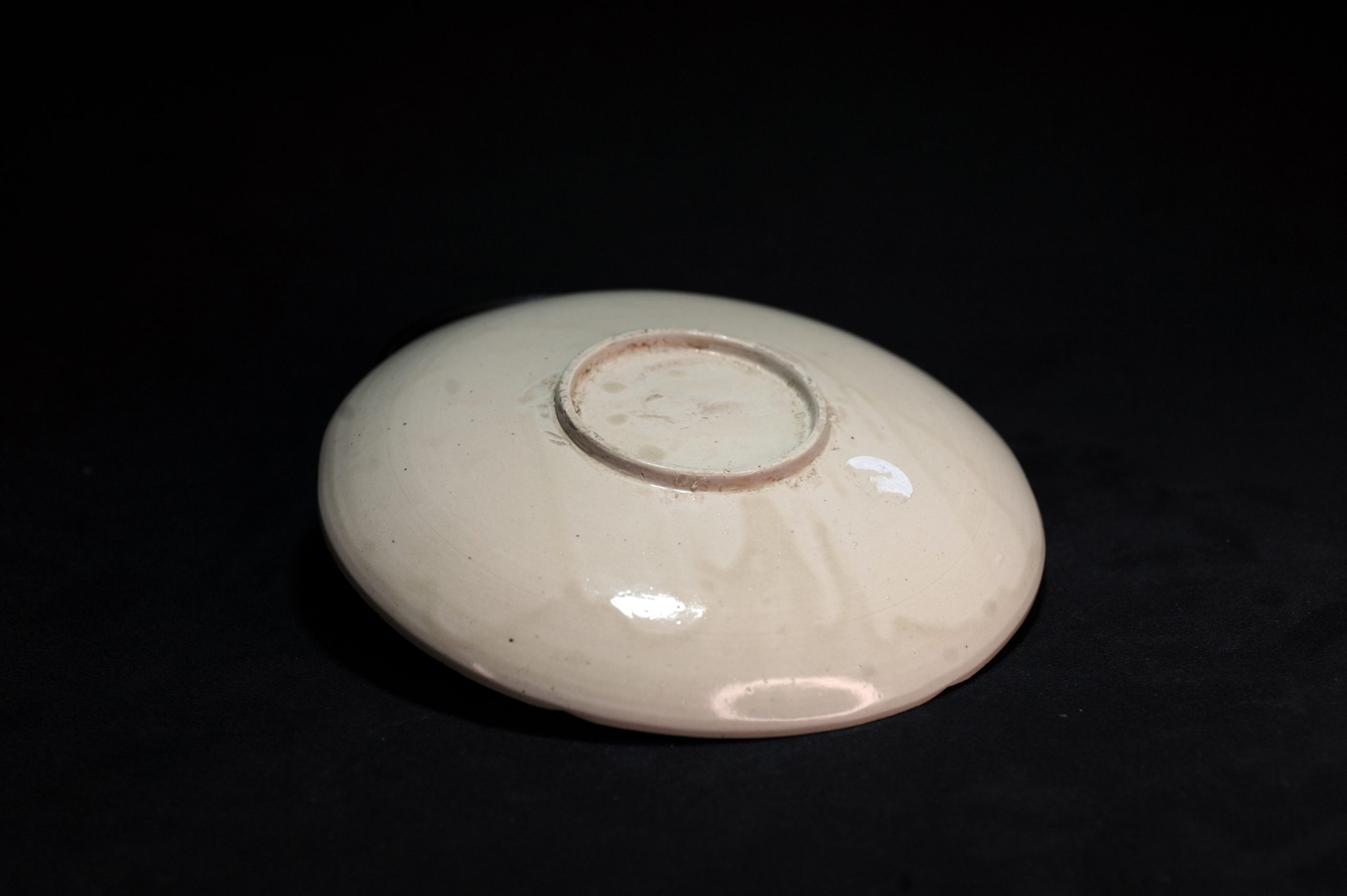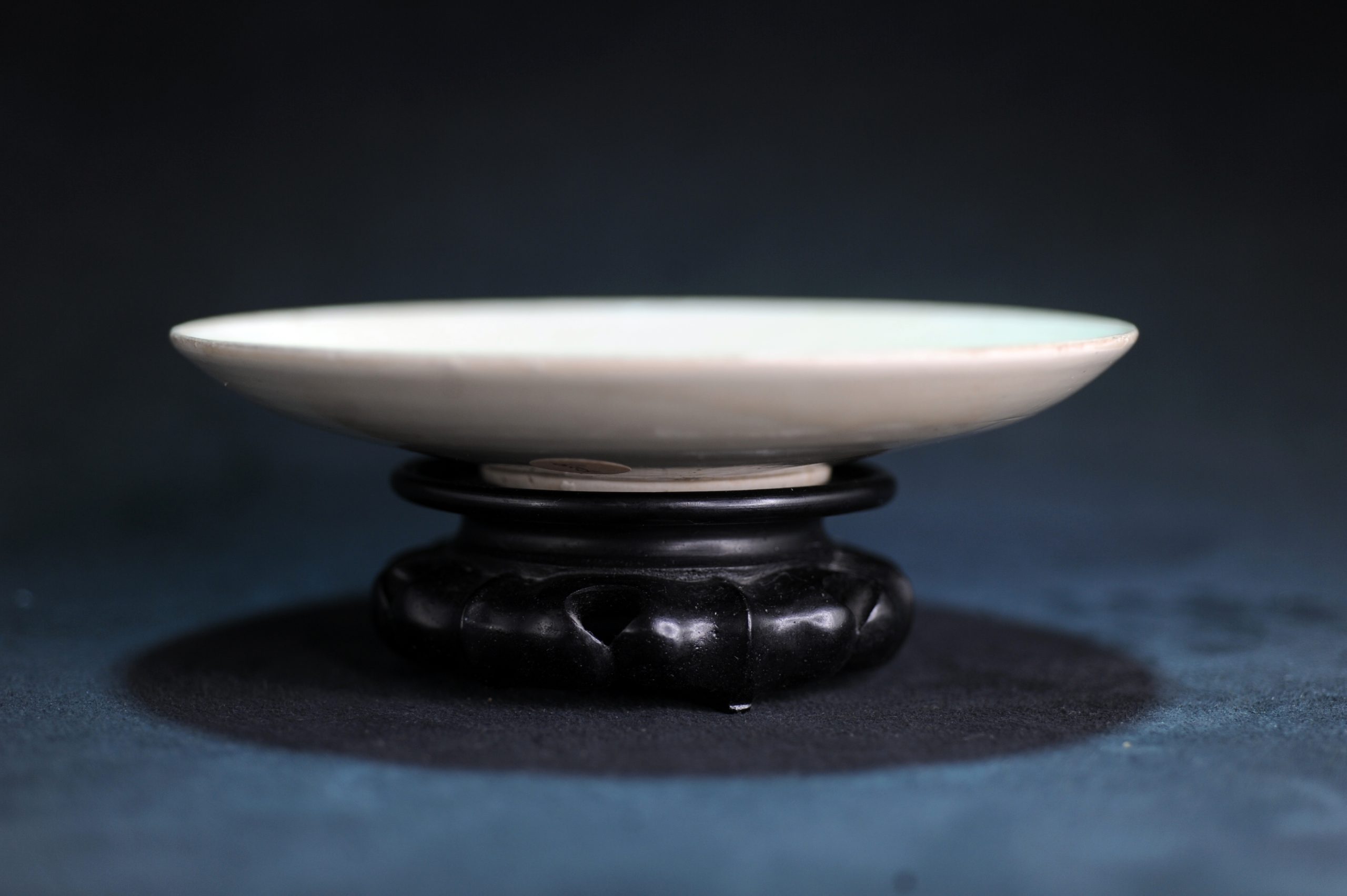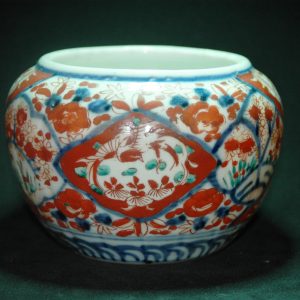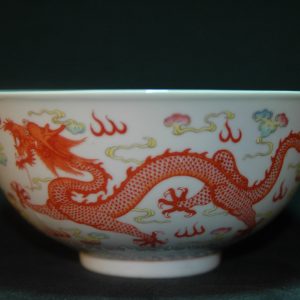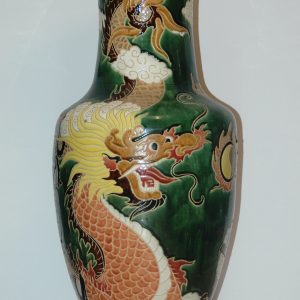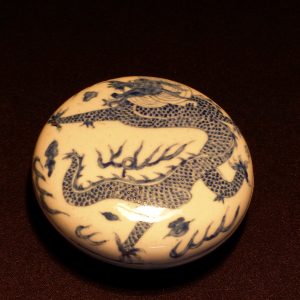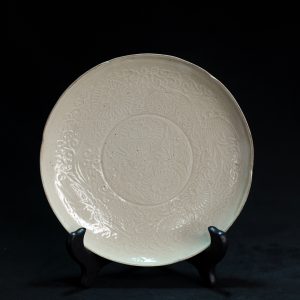Description
宋 定窑印凤凰穿缠枝花纹葵口盘
参考:佳士得
29 11月 2016 | 現場拍賣 12675
養德堂珍藏中國古陶瓷
拍品 3111
A RARE SMALL DING MOULDED ‘MANDARIN DUCKS’ DISH
金 定窯印花鴛鴦蓮池紋盤
JIN DYNASTY (1115-1234)
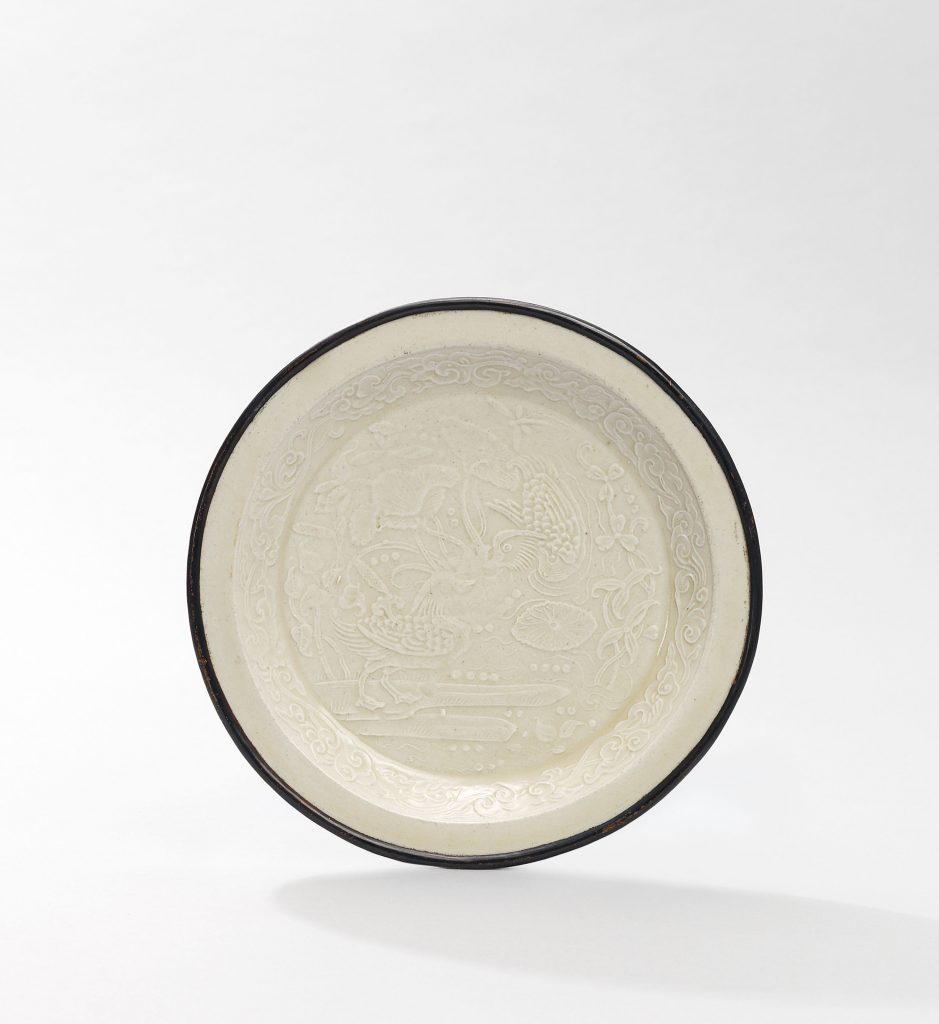
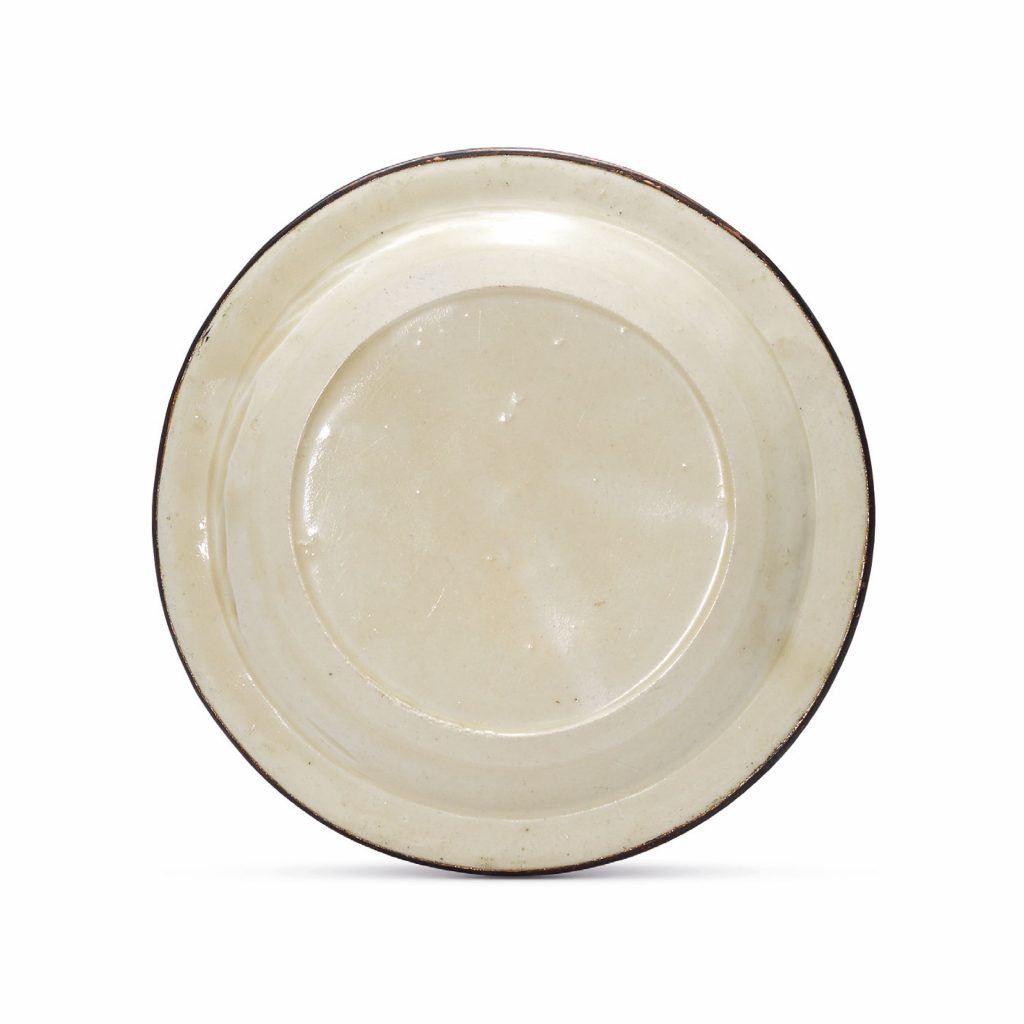
成交價 HKD 562,500
估價 HKD 300,000 – HKD 400,000
金 定窯印花鴛鴦蓮池紋盤
JIN DYNASTY (1115-1234)
5 5/8 in. (14.3 cm.) diam., box
狀況報告
謹請注意,所有拍品均按「現狀」拍賣,閣下或閣下的專業顧問應於拍賣前親自查看拍品以評鑑拍品之狀況。
– 整體品相良好。器面有輕磨損,屬正常現象
拍品專文
晉崔豹《古今注.鳥獸》:「鴛鴦,水鳥,鳧類也。雌雄未嘗相離,人得其一,則一思而死,故曰匹鳥。」以其作為裝飾圖案,古已有之。南朝梁簡文帝作《和徐錄事見內人作臥具》,內有「衣裁合歡,文作鴛鴦連」之句,後蜀顧 《甘州子》詞:「禁樓刁鬥喜初長,羅薦繡鴛鴦。」元代,蓮池鴛鴦圖案又稱「滿池嬌」。
有五件出版過的例子可資參考,第一件為仇焱之舊藏,著錄於《The Museum of Far Eastern Antiquities Bulletin: Sung Ceramics Designs》,第42期,斯德哥爾摩,1970年,圖版97b號;第二件藏芝加哥藝術博物館;第三件藏波士頓美術館,著錄於《Oriental Ceramics: The World’s Great Collections》,第10冊,東京,1980年,圖版17號;第四件藏洛杉磯郡藝術博物館,著錄於《Orientations》,2000年6月,78頁,圖9;第五件2014年11月26日於香港佳士得拍賣,拍品3224號。
参考:佳士得
3 10月 2016| 現場拍賣 12557
古今 | 佳士得
拍品 98
A MOULDED DING ‘LION’ DISH
北宋/金 定窯印獅子戲繡球紋盤
NORTHERN SONG-JIN DYNASTY (960-1234)
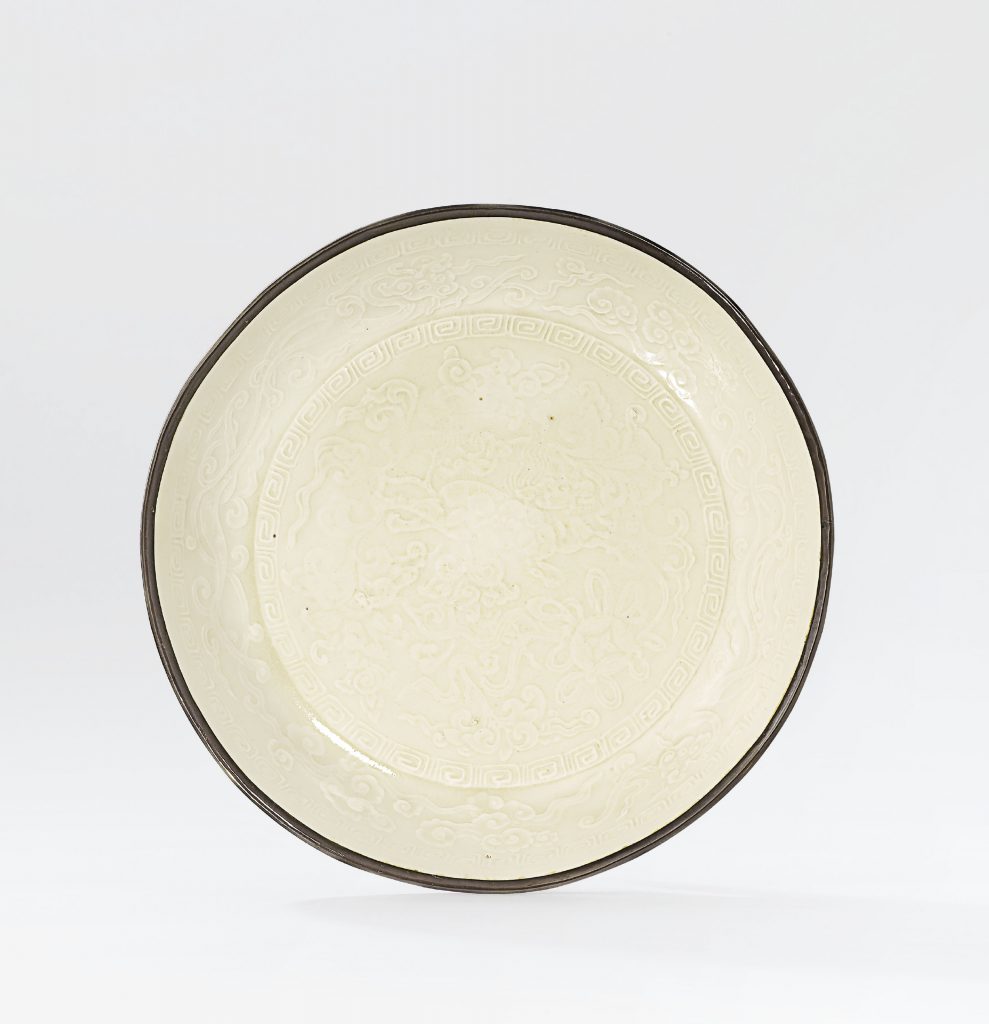
成交價 HKD 525,000
估價 HKD 350,000 – HKD 600,000
北宋/金 定窯印獅子戲繡球紋盤
A MOULDED DING ‘LION’ DISH
NORTHERN SONG-JIN DYNASTY (960-1234)
The dish is moulded on the centre of the interior with a galloping lion pursuing a tasselled brocade ball amidst scrolling vines, the well with two chilong divided by cloud scrolls, between two bands of keyfret, covered overall with a dark ivory-toned glaze. The rim is mounted with metal.
7 in. (17.7 cm.) diam., box
狀況報告
謹請注意,所有拍品均按「現狀」拍賣,閣下或閣下的專業顧問應於拍賣前親自查看拍品以評鑑拍品之狀況。
– 圈足有些許淺磕
– 口沿有少許輕微剝釉
参考:佳士得
15 9月 2016 | 現場拍賣 12175
中國瓷器及工藝精品
拍品 1312
A LARGE DINGYAO MOLDED DISH
VARIOUS PROPERTIES
金 定窯印花盤
JIN DYNASTY (1115-1234)
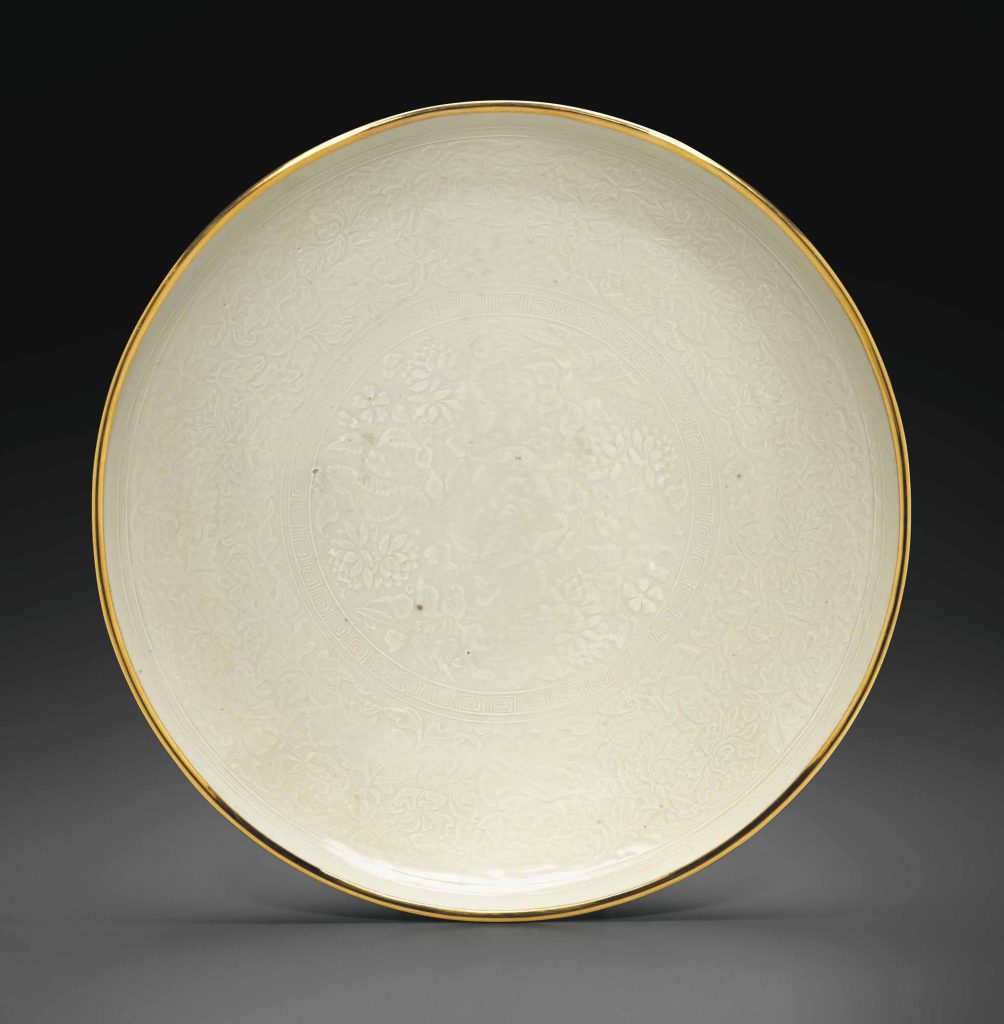
成交價 USD 68,750
估價 USD 20,000 – USD 30,000
細節
金 定窯印花盤
11 ¾ in. (29.8 cm.) diam., box
狀況報告
We have sought to record the changes in the condition of this piece acquired after its initial manufacture.
– short hairline crack extending from the mouth rim
– few pinprick holes, one with an associated y-shaped crack
– mouth is enclosed in a metal mount
– dish is slightly warped
– chips and nicks to foot rim
– a few firing cracks on the base
参考:佳士得
4 4月 2016 | 現場拍賣 12548
古今∣佳士得
拍品 63
A LARGE AND FINELY MOULDED DING ‘LOTUS’ DISH
北宋/金 定窯印荷塘牡丹紋大盤

成交價 HKD 1,240,000
估價 HKD 1,000,000 – HKD 1,500,000
北宋/金 定窯印荷塘牡丹紋大盤
來源
1960年代日本珍藏
日本壺中居
日本平野古陶軒
日本重要私人收藏
狀況報告
謹請注意,所有拍品均按「現狀」拍賣,閣下或閣下的專業顧問應於拍賣前親自查看拍品以評鑑拍品之狀況。
口沿有细冲线 长度约8cm
此外整体品相良好 但金属包口下的品相无法确认
参考:佳士得
2021年12月3日 | 現場拍賣 20195
淡掃蛾眉 – 頌德堂藏中國宋代瓷器
拍品 2839
北宋 定窯印花牡丹紋盌
NORTHERN SONG-JIN DYNASTY (960-1234)
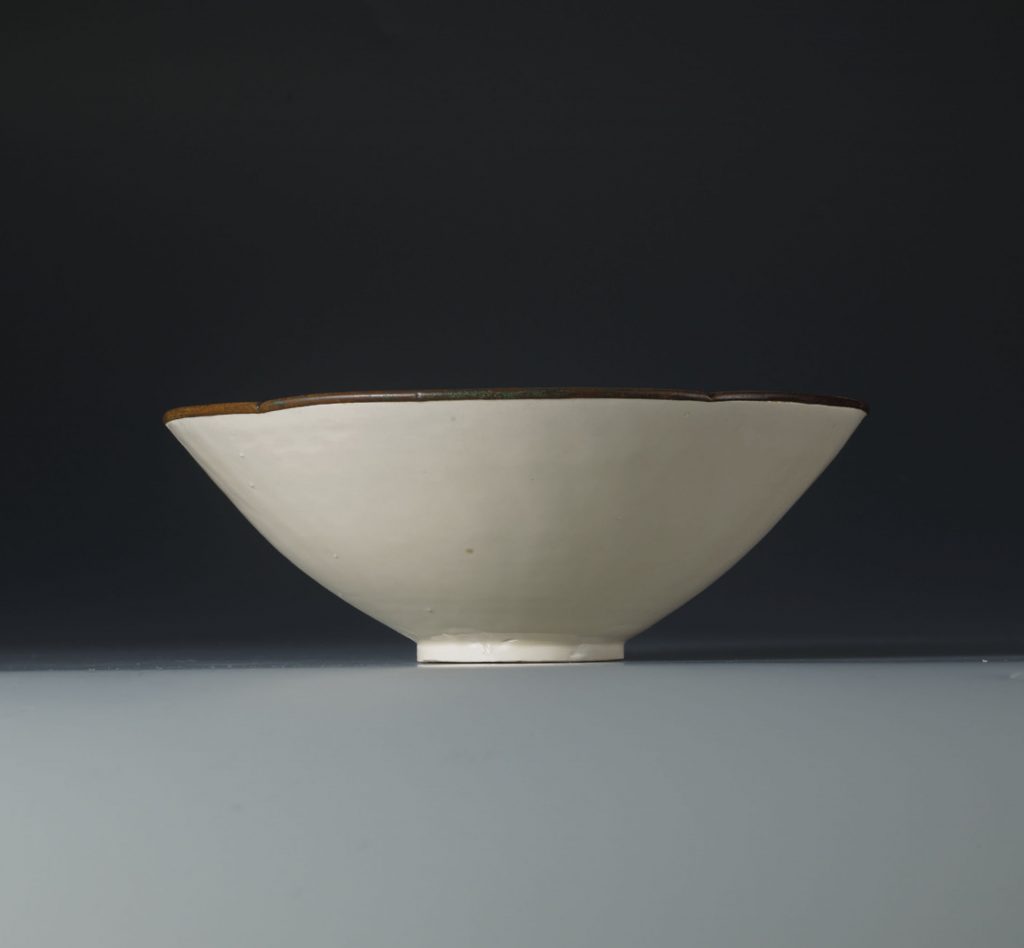
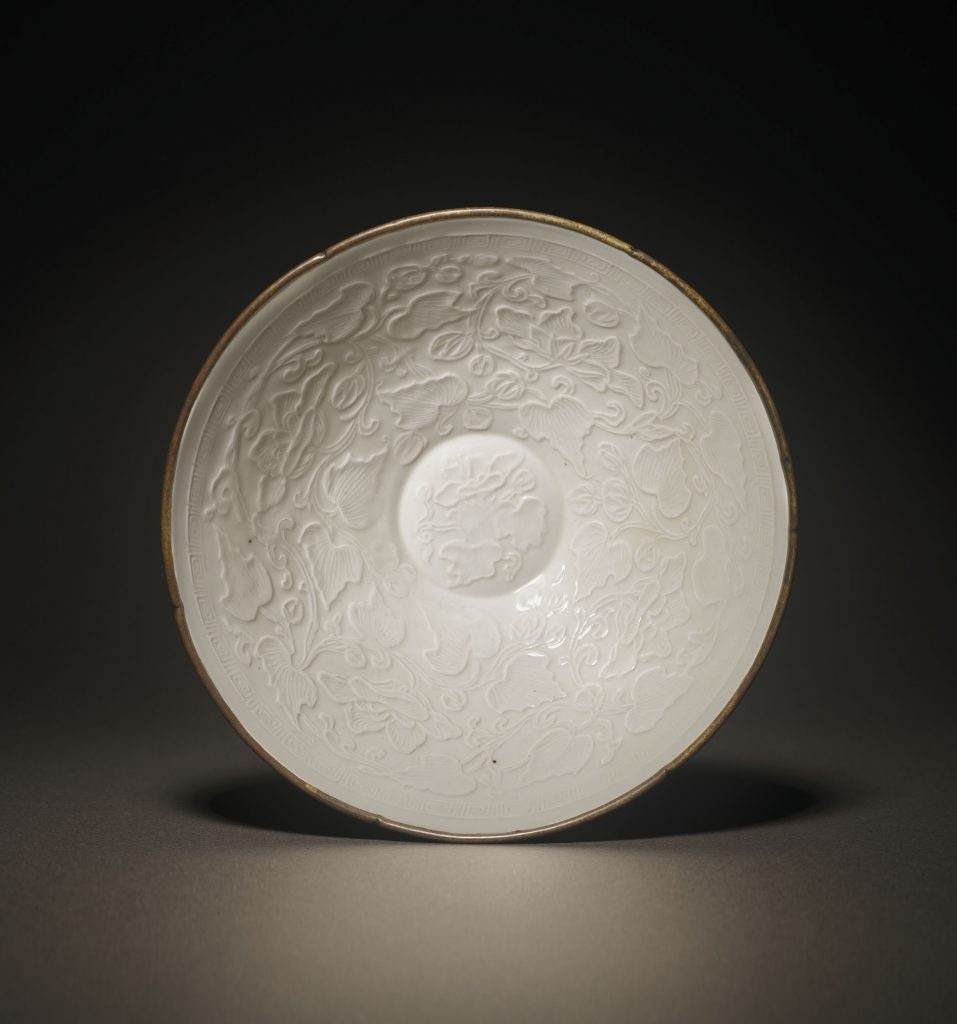
估價 HKD 700,000 – HKD 900,000
北宋 定窯印花牡丹紋盌
NORTHERN SONG-JIN DYNASTY (960-1234)
7 ½ in. (19 cm.) diam., box
展覽
香港大學美術博物館 ,《大繁若簡 – 宋金元朝的單色釉瓷展出》,2012 年,圖版 28 號
狀況報告
謹請注意,所有拍品均按「現狀」拍賣,閣下或閣下的專業顧問應於拍賣前親自查看拍品以評鑑拍品之狀況。
-整體品相良好
-釉面有些許磨損及輕微劃痕
拍品專文
此盌印紋清晰,釉色亮麗,品相完美,在已知的相關資料中只發現另一相同例子,藏於法國巴黎吉美博物館,屬館藏定窯常設展品之一,藏品編號MA4163 。
参考:苏富比
The Pilkington Collection of Chinese Art /
05 四月 2016 • 香港
拍品 80
金 定窰白釉印穿花祥鳳紋盤
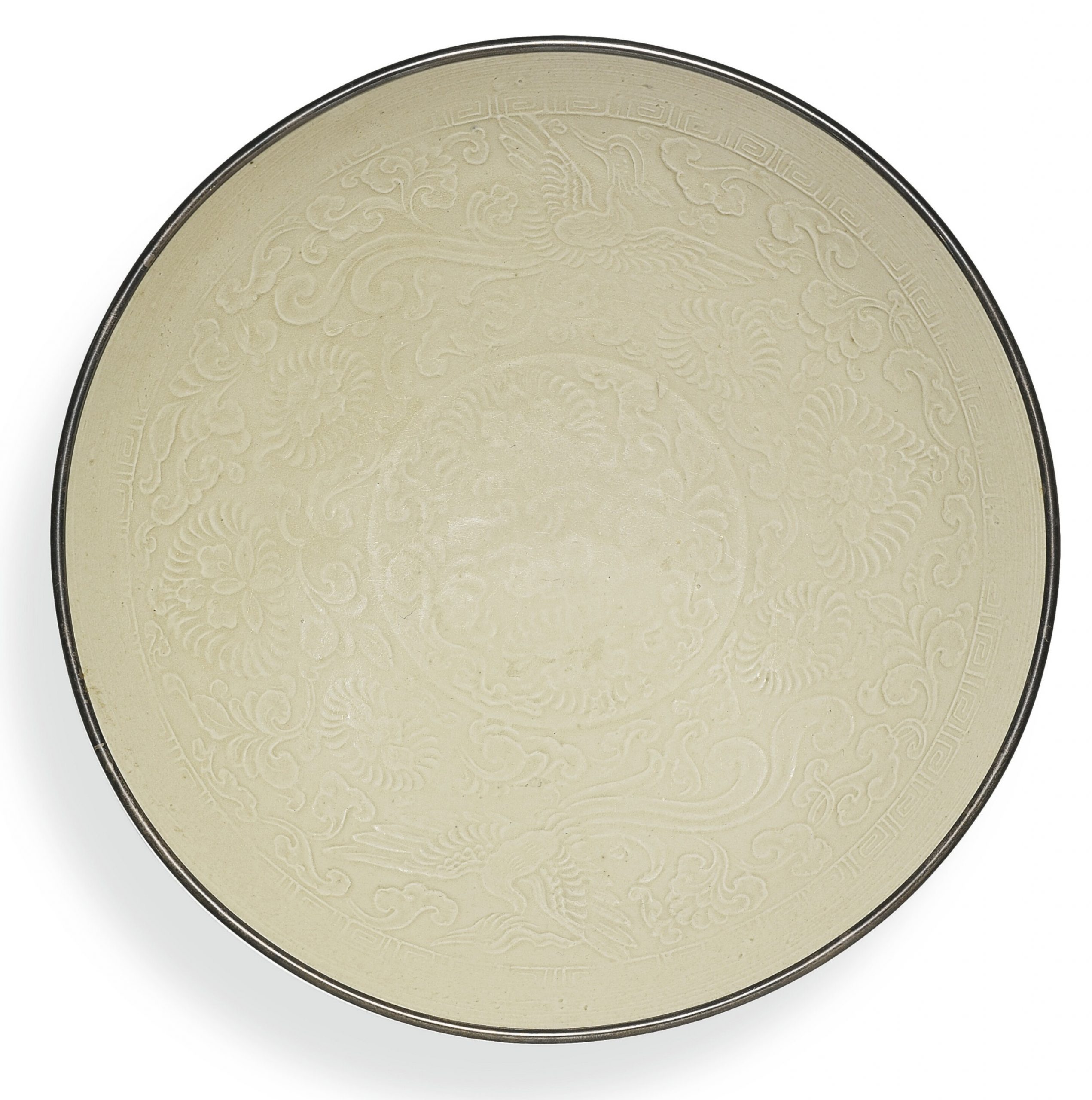
估價 60,000 – 80,000 HKD
已售出 325,000 HKD
描述
stoneware and silver
17.8 公分,7 英寸
the shallow rounded sides supported on a short neatly cut foot, crisply moulded to the interior with a central medallion enclosing two stylised floral blooms borne on meandering foliate scrolls, all encircled by a pair of phoenix in flight amongst similar floral scrolls, the details of the plumage meticulously picked out, encircled by a key-fret band just below the rim, covered overall in an ivory glaze pooling to characteristic teardrops on the exterior, the rim bound with silver
來源
內藤,日本,1965年3月14日
Bluett & Sons Ltd,倫敦,1965年 (£225)
羅傑琵金頓(1928-69年)收藏, 自1965 (£350)
拍品資料及來源
一相若盤例,藏於牛津阿什莫林博物館,錄於 Jan Wirgin 著,《Sung Ceramic Designs》,斯德哥爾摩,1970年,圖版85a;另一類例,無花卉紋飾,屬 Axel 及 Nora Lundgren 舊藏,現藏東亞博物館,斯德哥爾摩,載於Basil Gray著,《Sung Porcelain and Stoneware》,倫敦,1984年,圖版54。亦見兩類例。尺寸略大,售於倫敦佳士得,其一售於1982年12月13日,編號417,其二售於1986年12月8日,編號230。另有河北省曲陽縣出土一紋樣相似盌例,經修,錄《中國古瓷窰大系.中國定窰》,北京,2012年,圖版156。
参考:苏富比
中國藝術珍品Important Chinese Art
08 October 2019 • Hong Kong
拍品 3612
宋至金 定窰白釉持蓮童子紋盤
A DINGYAO MOULDED ‘BOY’ DISH SONG – JIN DYNASTY
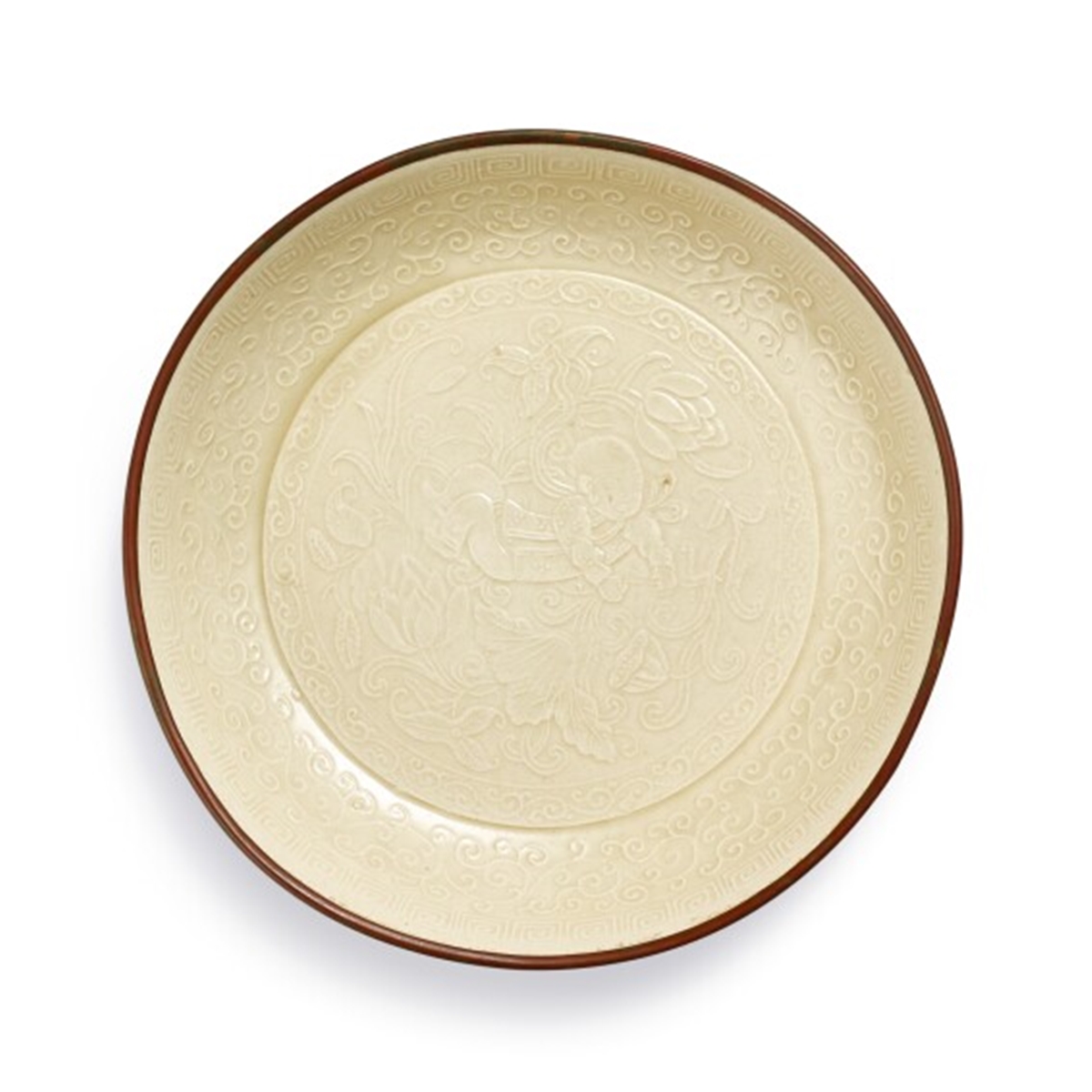
估價 2,400,000 – 3,200,000 HKD
已售出 3,000,000 HKD
描述Description
well potted with rounded sides rising from a flat, countersunken base, finely moulded to the centre on the interior with a boy clad in loose robes, his bald head turned to one side and his arms outstretched clasping onto a leafy spray of lotus pod, his body curled amidst lush lotus blooms, leaves, arrowheads and millet sprays, all enclosed within a classic scroll band, the curved well decorated with a further foliate scroll below a key-fret border, covered overall in a creamy ivory glaze, the rim bound in copper
参考:苏富比
Chinese Art Including Property from the Collection of Cheng Huan
18 December 2020 • 10:00 HKT • Hong Kong
Property of a Lady 女史珍藏
1002
A DINGYAO CARVED ‘LOTUS’ FOLIATE BOWL NORTHERN SONG DYNASTY
北宋 定窰葵口蓮紋盌
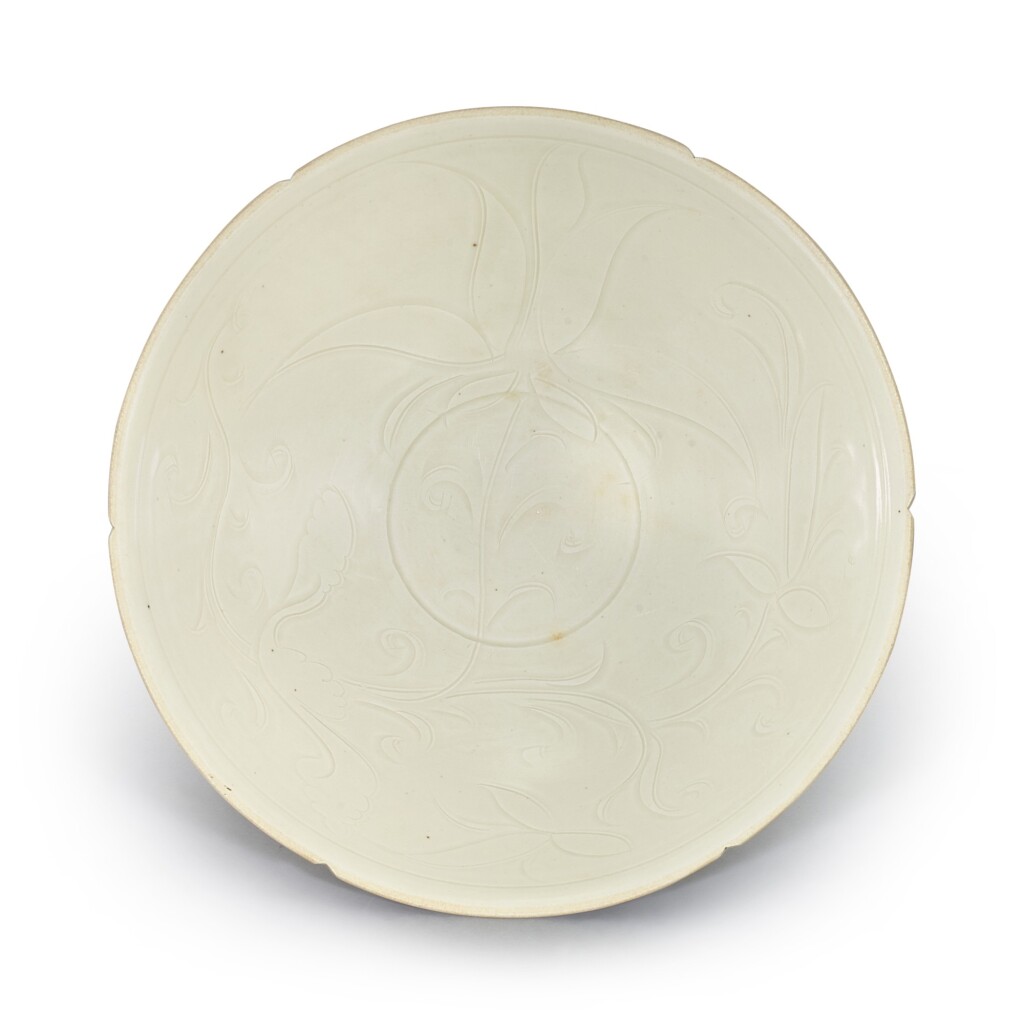
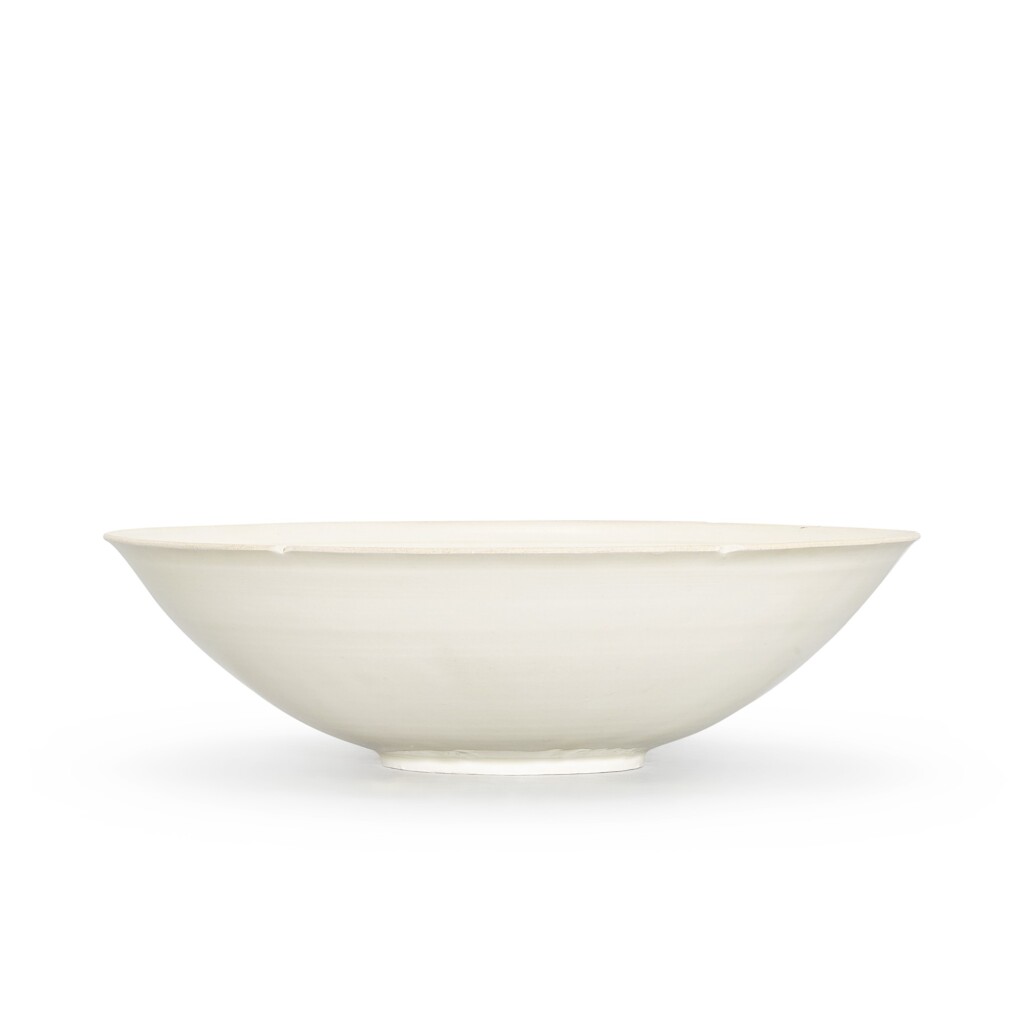
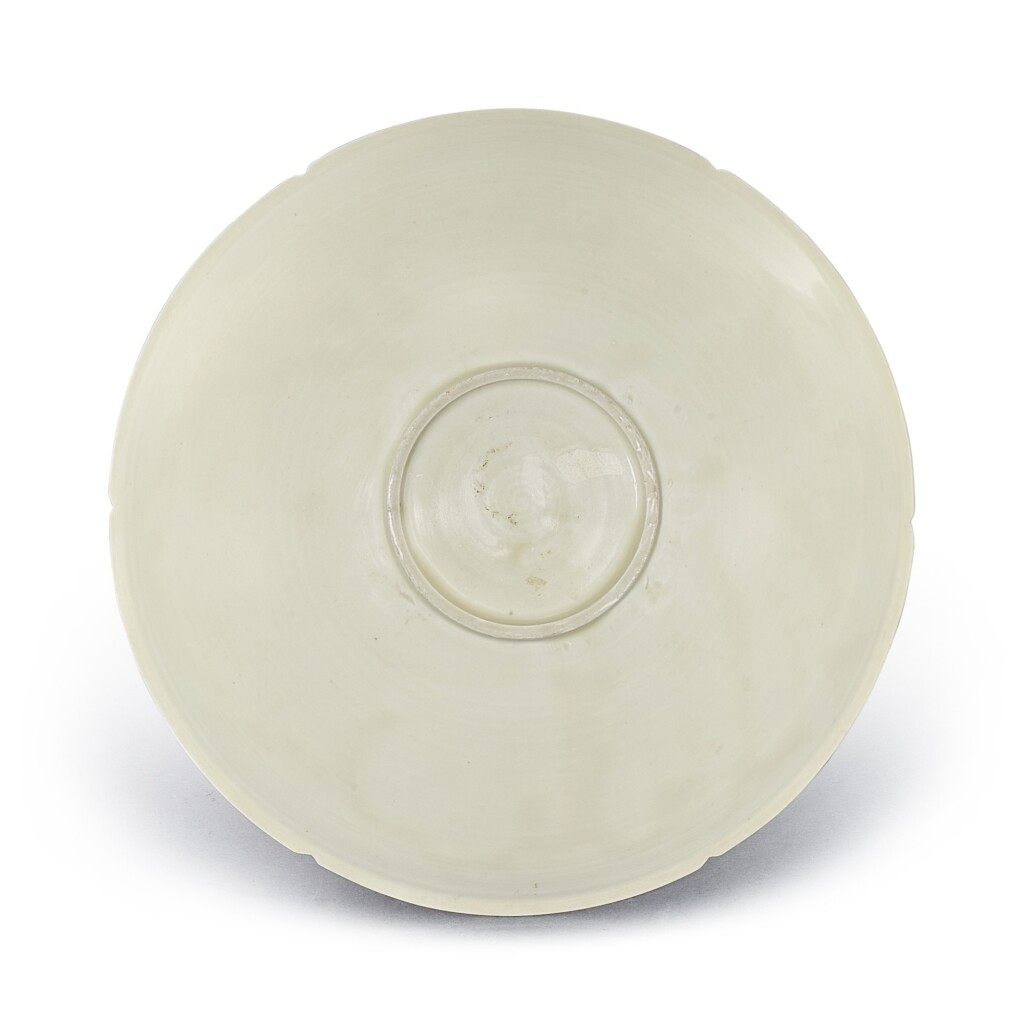
Estimate:180,000 – 250,000 HKD
Lot sold: 403,200 HKD
Description
Property of a Lady
A DINGYAO CARVED ‘LOTUS’ FOLIATE BOWL
NORTHERN SONG DYNASTY
女史珍藏
北宋 定窰葵口蓮紋盌
d. 21.5 cm
Condition Report
Good condition with just minute wear to the rim, and typical imperfections to the body.
整體品相良好,惟見口沿輕微磨痕及器體有窰燒瑕疵。
Provenance
A private family collection, Japan, acquired in the late Meiji to early Taisho period (1867-1925).
Christie’s New York, 22nd/23rd March 2013, lot 1435.
日本私人收藏,得自明治時期末至大正時期初(1867-1925年)
紐約佳士得2013年22/23日,編號1435
Catalogue note
A closely related Dingyao bowl carved with a similar design on the interior, from the Qing Court collection and still in Beijing, is illustrated in The Complete Collection of Treasures of the Palace Museum. Porcelain of the Song Dynasty, Hong Kong, 1996, p. 60, no. 52.
参考:佳士得
15 3月 2015 | 現場拍賣 3720
重要中國瓷器及工藝精品
拍品 3246北宋 定窯白釉刻蓮紋花口盤
A DINGYAO CARVED HEXALOBED DISH
PROPERTY FROM A PRIVATE COLLECTION
NORTHERN SONG DYNASTY, 12TH-13TH CENTURY
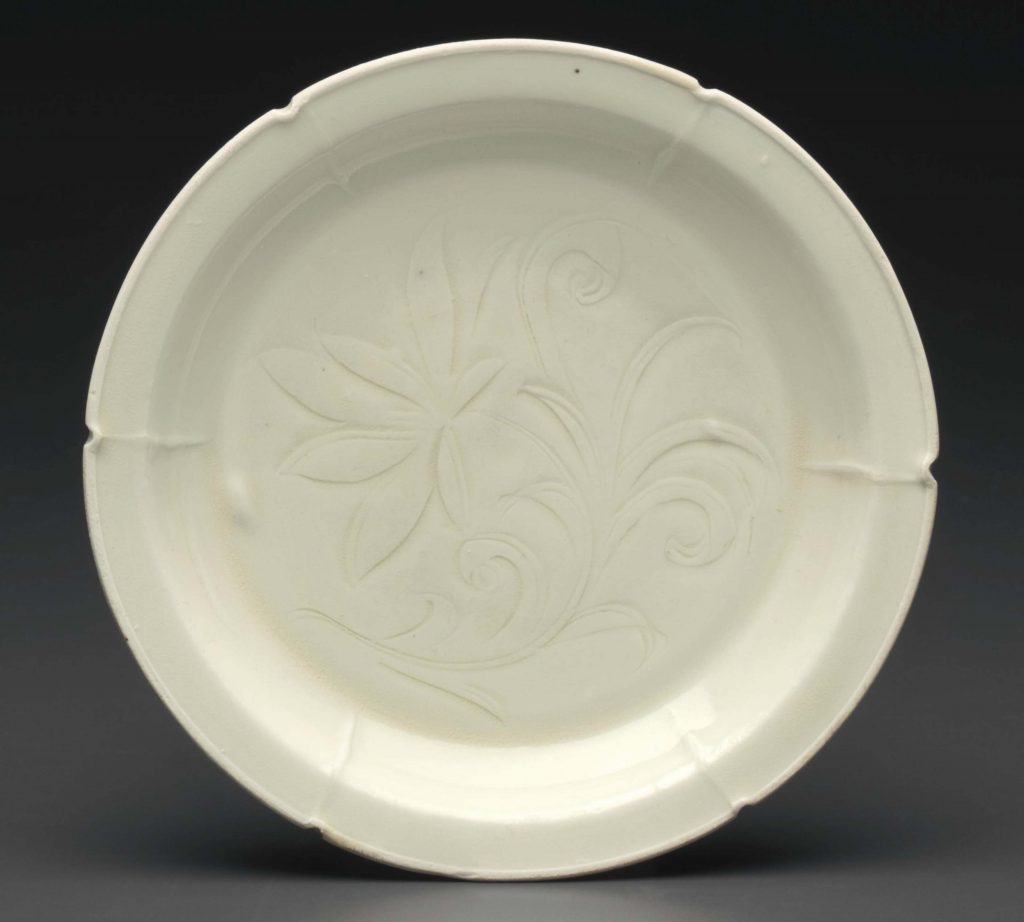
成交價 USD 52,500
估價 USD 12,000 – USD 18,000
來源
Christie’s London, 10 December 1990, lot 100.
狀況報告
-two areas of restoration and minor fritting to the mouth rim
-expected surface wear and light scratching
参考:佳士得
15 3月 2015 | 現場拍賣 3720
重要中國瓷器及工藝精品
拍品 3235北宋 定窯白釉刻蓮紋盤
A DINGYAO CARVED ‘LOTUS’ DISH
VARIOUS PROPERTIES
NORTHERN SONG DYNASTY (AD 960-1127)

成交價 USD 43,750
估價 USD 50,000 – USD 70,000
來源
Private collection, Japan, formed in the 1940s.
狀況報告
– The dish appears to be in good overall condition
– As can be seen in the illustration, the mouth rim is a little warped and there is a small iron spot in the glaze
– There is the expected light wear to the glaze and some small scratches to the interior
– There are a few small minor firing cracks in the foot rim
– There are some small spots of minor pitting on the exterior
– There is an unglazed patch on the underside of the base, and two finger smears in the glaze on the exterior, which are associated with manufacture
– There is expected minor potting irregularity to the foot
参考:佳士得
25 11月 2014 | 現場拍賣 3371
重要中國瓷器及工藝精品
拍品 3225 金 定窑模印穿花鸟纹盘
A LARGE MOULDED DING ‘BIRDS’ DISH
VARIOUS PROPERTIES
JIN DYNASTY (1115-1234)

成交價 HKD 1,540,000
估價 HKD 800,000 – HKD 1,500,000
A LARGE MOULDED DING ‘BIRDS’ DISH
JIN DYNASTY (1115-1234)
The dish is well potted with rounded sides rising to a metal-bound rim, moulded on the interior with a central medallion enclosing a pair of mandarin ducks amidst scrolling lotus, encircled by a band of peacocks in flight amongst peony scrolls on the cavetto. The exterior is plain. The dish is covered with a clear glaze of warm ivory tone, revealing the white biscuit on the foot.
11 3/8 in. (29 cm.) diam.
狀況報告
– There are two small chips to the mouth rim, which are covered underneath the metal rim, with a small associated area of stain.
拍品專文
Ding dishes decorated with peacocks are rare, but those decorated with a combination of peacocks and mandarin ducks are even more so. The peacock seems to be closely connected with the phoenix in Chinese art, not only in its physical attributes but the birds are also found together and sometimes the peacock seems to be a substitute for the phoenix. Symbolic of beauty and dignity, the Book of Changes (Yijing) calls the peacock a cultured bird that brings civilisation to the world. When depicted in pairs they are likely to symbolise happy marriage. One closely related example with this rare decoration is known, which is a dish of almost the same size and shape in the Beijing Palace Museum, similarly moulded with four peacocks in flight on the cavetto, encircling a pair of birds in the centre identified by the Museum as wild-geese, illustrated in Selection of Ding ware: the Palace Museum’s Collection and Archaeological Excavation, Beijing, 2012, pl. 85.
参考:佳士得
27 5月 2014| 現場拍賣 3323
漱玉供菊 – 宋代藝術精品
拍品 3211 北宋 定窑花瓣葵口盘
AN IMPORTANT FINE AND RARE DING FLORAL-LOBED SHALLOW BOWL
THE PROPERTY OF AN ASIAN COLLECTOR
NORTHERN SONG DYNASTY (960-1127)
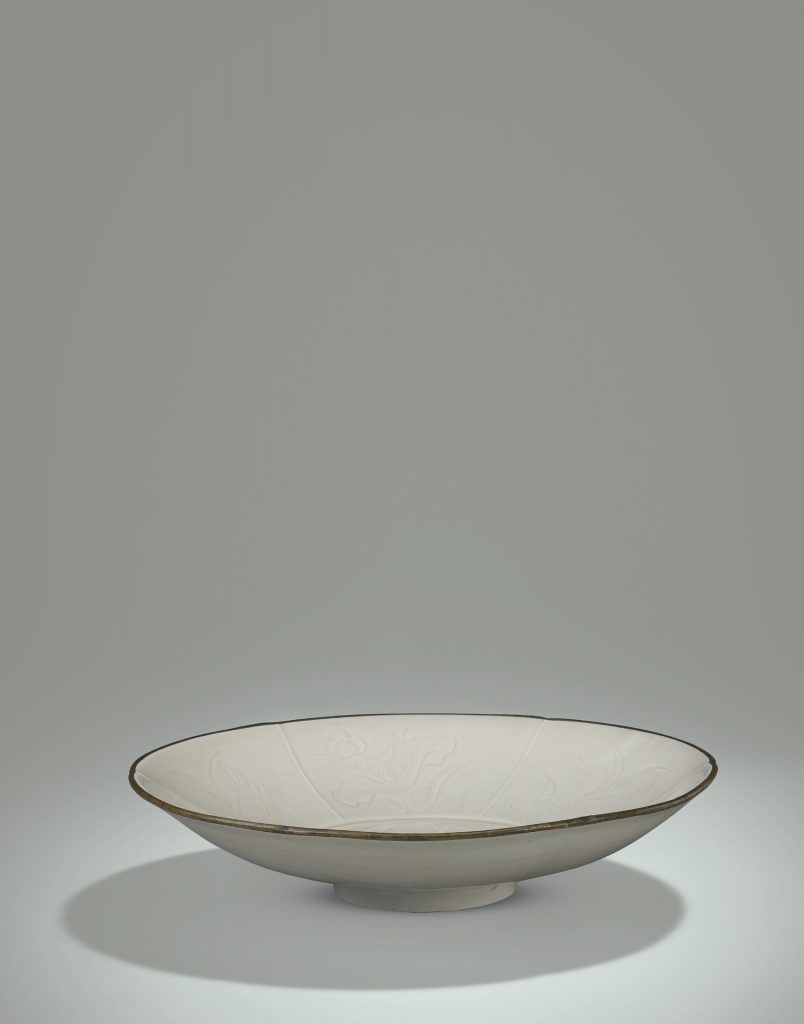
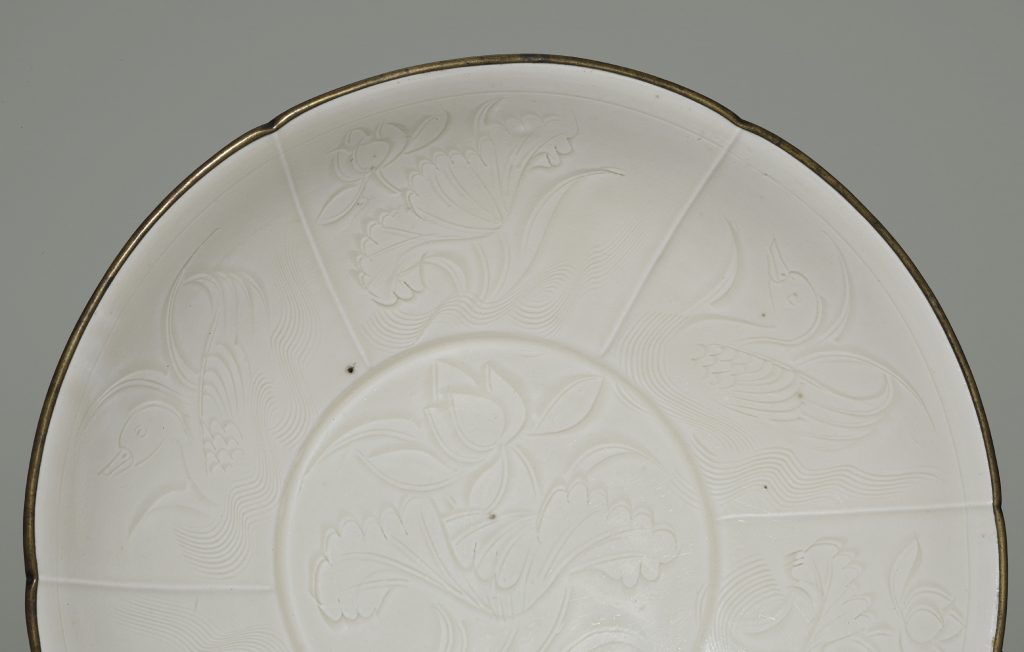
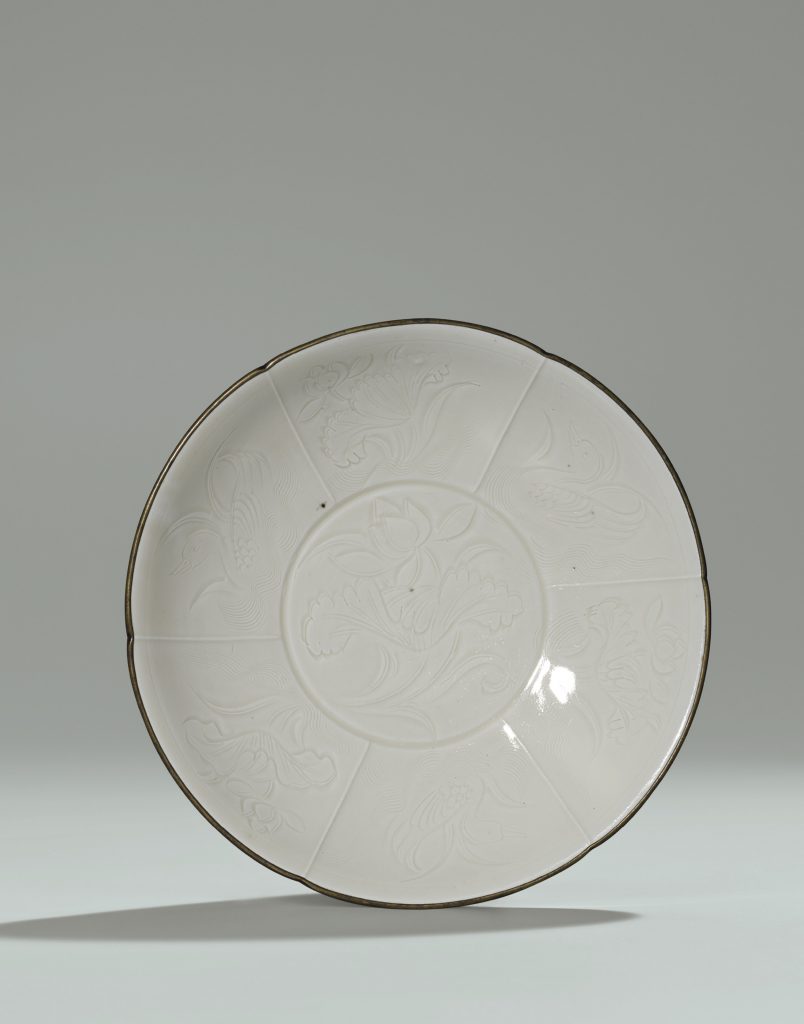
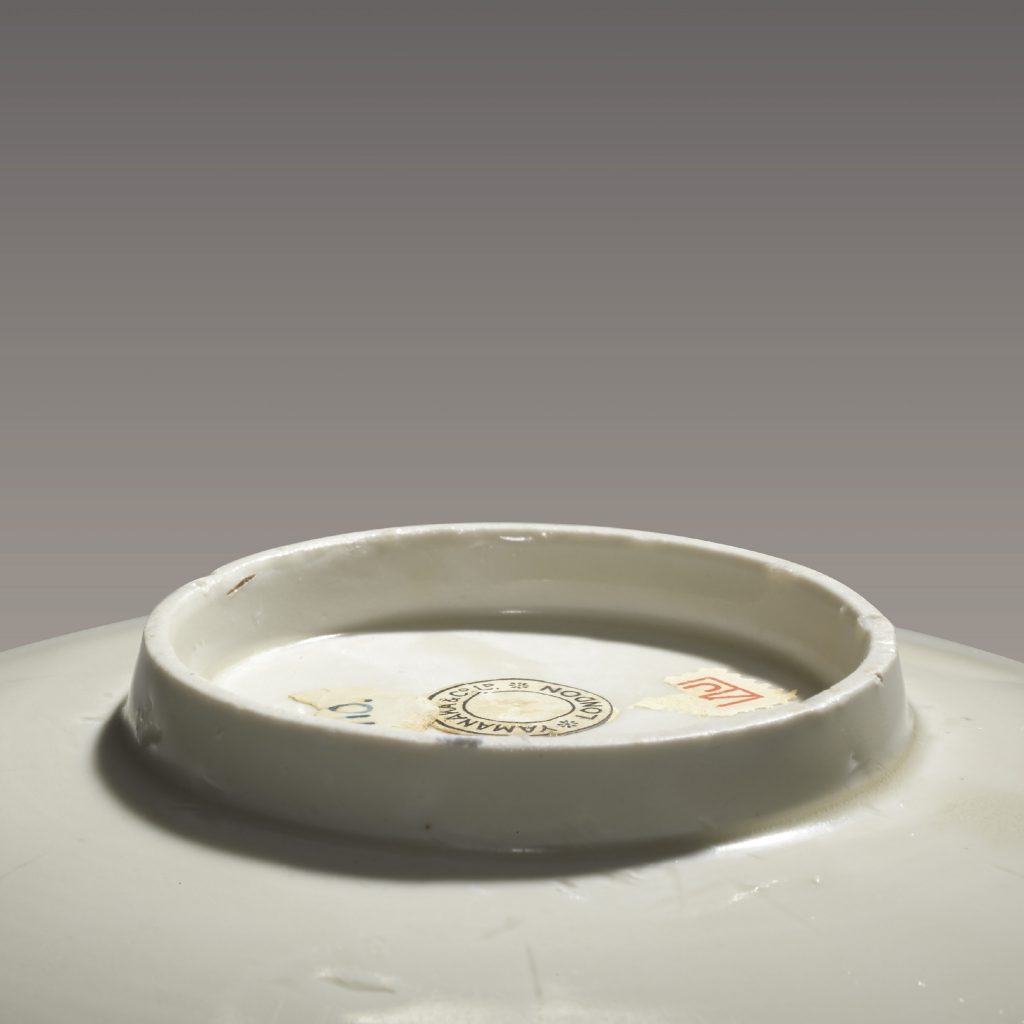
成交價HKD 28,120,000
估價HKD 16,000,000 – HKD 25,000,000
AN IMPORTANT FINE AND RARE DING FLORAL-LOBED SHALLOW BOWL
NORTHERN SONG DYNASTY (960-1127)
The bowl is formed of hexagonal lobed sides, rising from a short tapering foot to an indented mouth rim. The interior is freely incised, and combed for details, to depict a flowering lotus spray within a medallion at the centre and surrounded by panels of smiliar lotus spray alternating with a duck swimming amidst water weeds around the cavetto. Covered in an ivory glaze with characteristic pooling into a deeper tone in the recesses. The mouth rim is copper bound.
7 7/8 in. (20 cm.) wide, box
來源
Yamanaka & Co., London
Dr Carl Kempe (1884-1967)
Sold at Sotheby’s London, 14 May 2008, lot 258, front cover
出版
‘Hsing-yao and Ting-yao’, The Bulletin of Far Eastern Antiquities, no. 25, 1953, pls. 84, 85, fig. 73
Bo Gyllensvard, Chinese Ceramics in the Kempe Collection, Stockholm, 1964, pl. 456
Jan Wirgin, Sung Designs, Stockholm, 1970, pl. 64a, fig. 8e
The World’s Great Collections, Oriental Ceramics, vol. 8, 1982, pl. 108
Chinese Ceramics in the Carl Kempe Collection, The Museum of Far Eastern Antiquities in Ulricehamn, Ulricehamn, 2002, pl. 658
展覽
New York, Chinese Gold, Silver and Porcelain. The Kempe Collection, Asia House Gallery, 1971, Catalogue, no. 110; and exhibited in nine other museum in the United States
狀況報告
– In good overall condition.
拍品專文
This exceptional bowl is a classic example of the finest Song dynasty Ding ware, so admired by the Imperial court. Its glossy ivory glaze perfectly complements the fine-textured white body, while the refined decoration complements its elegant form. The lobed form, almost certainly derived from metalwork, is one that provided a significant test for its potter, when combined with carved decoration. Indeed the technique used for the carved and incised design on this bowl provides an excellent demonstration of how well this subtle decoration can be applied to a white body under an essentially colourless glaze. The ceramic artist held his knife at an angle to obtain a sharp and a graded edge to each stroke, and has often added a secondary parallel line to strokes he wished to emphasise. To depict the water he used a comb-like tool to produce thin parallel lines simulating the ripples on the lotus pool.
While ducks on a pond with aquatic plants is a popular motif on Northern Song Ding ware dishes, the most usual scheme for the design is with two ducks, one above the other in the same orientation. Examples of these were included in the exhibition, Decorated Porcelains of Dingzhou, White Ding wares from the collection of the National Palace Museum, Taipei, 2014, pp. 123-126, nos. II.73 – II.76 and p. 128, no. II.78. On the current bowl, however, the interior lobes are each decorated with a lotus spray alternating with a swimming duck. This arrangement of motifs is exceptionally rare and appears to be unique. A similarly carved six-lobed bowl, without the swimming ducks, dating to the Jin period was also included the National Palace Museum exhibition, and illustrated, op. cit., p. 84, no. II.39.
参考:佳士得
18 9月 2014| 現場拍賣 2872
中國瓷器及工藝精品
拍品 733
A RARE DINGYAO INCISED ‘DAYLILY’ DEEP BOWL
北宋 十一至十二世紀 定窰白釉萱草紋盌
NORTHERN SONG DYNASTY, 11TH-12TH CENTURY
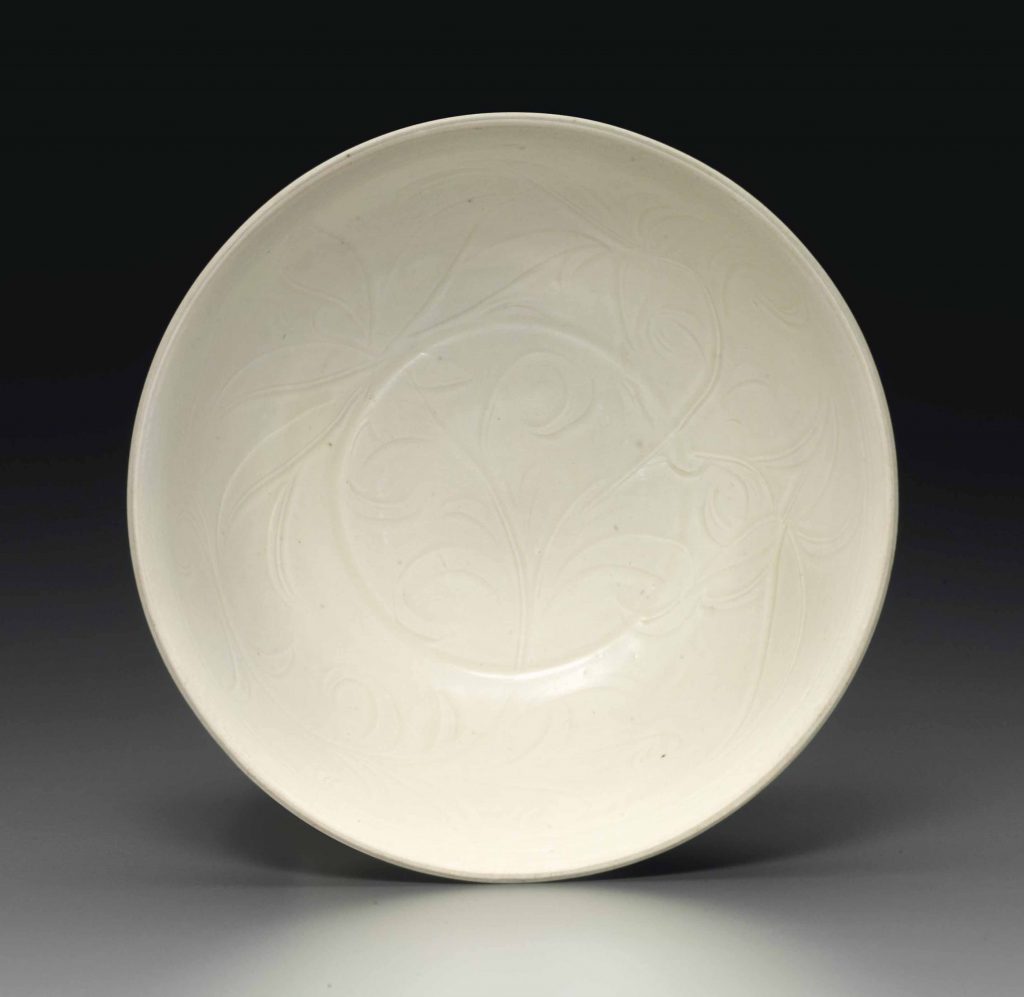
定窰白釉萱草紋盌
成交價 USD 245,000
估價 USD 220,000 – USD 300,000
來源
Baron Fujita Family Collection, Japan, acquired in the early 20th century.
狀況報告
-there are a few minor paper-like iron specks in the glaze
-In excellent overall condition with exception of wear and light scratching to sufaces as can be expected
拍品專文
The present bowl is exceptionally well carved with freely rendered daylilies. Compare to several Ding vessels bearing this design, including a basin of larger size from the National Palace Museum, Taipei, illustrated in Catalogue of the Special Exhibition of Ting Ware White Porcelain, Taipei, 1987, no. 28; a conical bowl from the Linyushanren Collection, included in The Classic Age of Chinese Ceramics: An Exhibition of Song Treasures from the Linyushanren Collection, Hong Kong, 2012, no. 1; and a larger basin, also from the Linyushanren Collection, ibid., no. 9.
参考:佳士得
18 9月 2014 | 現場拍賣 2872
中國瓷器及工藝精品
拍品 731
A MOLDED DINGYAO BOWL
北宋-金 十一至十二世紀 定窰白釉模印纏枝牡丹紋盌
NORTHERN SONG-JIN DYNASTY, 11TH-12TH CENTURY

成交價 USD 52,500
估價 USD 25,000 – USD 35,000
來源
Collection of Dr. Ando, Aiichi prefecture, Japan, 1930s.
狀況報告
-the mouth rim is enclosed with a metal mount
-light surface abrasion and scratches
– there is pale pink hue surrounding the exterior mouth rim and continuing to one part of the interior mouth rim, which is most likely due to the metal mount
参考:佳士得
18 9月 2014 | 現場拍賣 2872
中國瓷器及工藝精品
拍品 732
A RARE DINGYAO CARVED DISH
Property From a Private West Coast Collection
北宋 十一至十二世紀 定窰白釉刻穿花龍紋盤
NORTHERN SONG DYNASTY, 11TH-12TH CENTURY
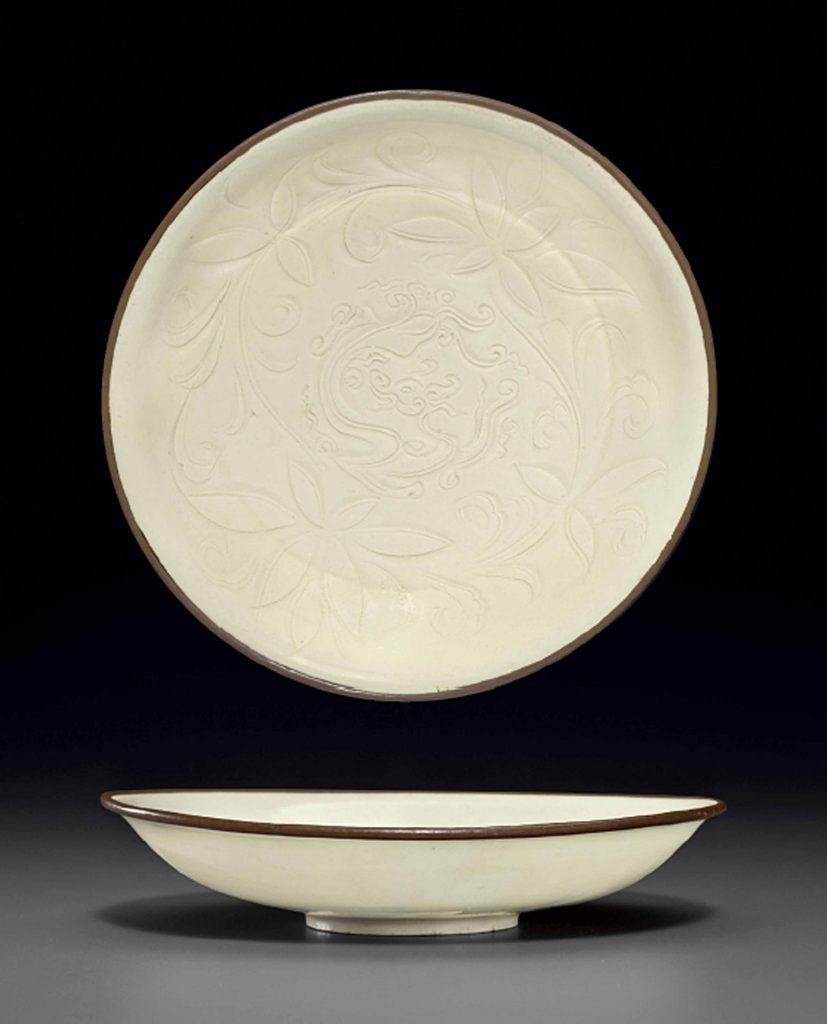
成交價 USD 161,000
估價 USD 60,000 – USD 80,000
細節
北宋 十一至十二世紀
定窰白釉刻穿花龍紋盤
來源
By family tradition, given as a gift from Alfred Stieglitz to Georgia O’Keefe, who gifted it to the mother of the current owner in the early 1950s.
狀況報告
– the dish appears to be in overall good condition
– the dish is slightly warped
– there are some minute areas of black speckling, which is inherent to manufacture
– there are some minute nicks to the foot rim
拍品專文
Created at the Ding kilns, in Hebei province, this exquisite dish represents the type of ceramic ware most preferred at the Imperial Court in the late eleventh and early twelfth century. The delicately carved lotus scroll on the interior encircles the principal decorative motif, a rarely encountered chilong, or hornless dragon, which appears at the center of the vessel’s floor.
An ancient mythological creature that appears in Chinese literature at least as early as the Warring States period (481-221 BC), the chilong is characteristically presented as a young, playful creature. When shown singly, as in this dish, it typically turns its head to look over its back and toward its tail, thus assuming a C-shape. In other instances, the chilong may be depicted together with one or two additional chilong, and occasionally together with a mature dragon, or long, the mature dragon typically identified as the mother; in such “family presentations”, the several chilong generally frolic around their mother, playing with each other and even climbing over their mother’s back.
Like its close relative, the mature long dragon, the chilong is an auspicious emblem that denotes high status and conveys to the viewer every good wish for success and prosperity. Moreover, the Lushi Chunqiu – a text written around 239 BC by Lu Buwei (290-235 BC) and whose title can be translated as Master Lu’s Spring and Autumn [Annals] – attributes to Confucius (551-479 BC) a quote in which he compares long “dragons”, chi “hornless dragons”, and yu “fish” and then likens himself to a hornless dragon: “Master Kong [i.e., Confucius] said, ‘The dragon eats and swims in clear water; the hornless dragon eats in clean water but swims in muddy water; fish eat and swim in muddy water. Now, I have not ascended to the level of a dragon, but nor have I descended to that of fish; perhaps I am a hornless dragon!'” (Quotation adapted from John Knoblock and Jeffrey K. Riegel, The Annals of Lu Buwei, Stanford, 2000, p. 505.) Confucius’ likening of himself to a chilong assured that creature an elevated status in Chinese mythology as well as an honored place in the repertory of decorative-arts motifs.
Although the lotus scroll that embellishes this dish is the most typical motif in Ding ware produced during the Northern Song period (960-1127), the chilong, by contrast, is a motif only rarely encountered amongst Song ceramics. This dish’s chilong-and-lotus dcor is virtually identical to that on a bowl in the National Palace Museum, Taipei. (See Gugong Songzi Tulu (Illustrated Catalogue of Sung Dynasty Porcelain in the National Palace Museum), Dingyao – Dingyaoxing (Ding Ware and Ding-type Ware), Tokyo, 1973, no. 44.) It also relates closely to that on a bowl in the Palace Museum, Beijing. (See Zhongguo Taoci Quanji / Chugoku Toji Zenshu (A Compendium of Chinese Ceramics), vol. 9, Dingyao / Teiyo (Ding Ware), Shanghai and Tokyo, 1981, pl. 77.) In addition, the decorative scheme on this dish is also very close in style and general appearance to that on two bowls formerly in Swedish private collections: one formerly in the Carl Kempe Collection, Stockholm, and one formerly in the J. Hellner Collection, Stockholm. Both bowls are published by Jan Wirgin in Sung Ceramic Designs, London, 1979, pp. 138-39, Type: Ti 27, pl. 69a (Ex-Kempe Collection) and pl. 69b (Ex-Hellner Collection).
Collectors of the Ming (1368-1644) and Qing (1644-1911) dynasties ranked Ding ware among the “five great wares of the Song”, along with Jun, Ru, Guan, and Ge wares. Celebrated for their porcellaneous white wares, the Ding kilns also produced pieces with russet and black glazes. Although not imperial kilns per se – that is, they were not operated by the government and did not produce ceramics exclusively for the imperial household – the Ding kilns nevertheless supplied substantial quantities of ceramic ware to the palace in the late tenth, eleventh, and early twelfth centuries.
Produced at a number of small kilns in Quyang county (in central Hebei province, about 100 miles to the southwest of Beijing), Ding ware is so named because Quyang county fell within the Dingzhou administrative district during the Northern Song period (960-1127). As evinced by this dish, elegant forms derived from contemporaneous silver and lacquer typify the ware, as do thin walls that result in pieces of unusually light weight. The smooth, fine-grained bodies of Ding ceramics are pure white; composed almost entirely of kaolin, the bodies are only slightly translucent, transmitting a warm orange light when they transmit light at all. Thin and pale, their ivory-hued glazes impart a warm tone. Connoisseurs early on recognized that runs of glaze, which they termed “tear drops”, characteristically appear on the exteriors of Ding vessels, as they do on this shallow dish.
Ding vessels from the tenth and early eleventh century are usually undecorated, though they often suggest natural forms, circular bowls with notched rims suggesting open blossoms, for example, the notches separating one petal from the next. Ding vessels from the late eleventh and early twelfth century typically sport incised and carved decoration, while those from the mid-twelfth through the thirteenth century characteristically boast mold-impressed decoration.
From the late eleventh century onward, white Ding bowls and dishes were stacked upside down in their saggars, or ceramic firing containers, in order to increase kiln efficiency; their mouth rims were wiped free of glaze slurry before firing to prevent the bowls from fusing to the saggar in the heat of the kiln. The bowls and dishes were banded with metal after firing to conceal the unglazed rim.
Ding wares were fired in small, mound-shaped kilns known in Chinese as mantou yao, or “dumpling kilns”, the name resulting from their similarity in shape to that of Chinese dumplings, or mantou. Although fired with wood in the late Tang (618-907) and Five Dynasties (907-960) periods – their earliest phase of development – the Ding kilns came to rely on coal as fuel beginning in the tenth century. As a reducing atmosphere is difficult to achieve when firing with coal, most Northern Song Ding vessels were fired in an oxidizing atmosphere, which explains the ivory hue of the glaze.
Robert D. Mowry
Alan J. Dworsky Curator of Chinese Art Emeritus, Harvard Art Museums, and
Senior Consultant, Christie’s
参考:佳士得
21 3月 2013 | 現場拍賣 2689
中國瓷器及工藝精品
拍品 1441
A RARE DINGYAO CARVED FOLIATE-RIMMED SHALLOW BOWL
北宋 定窰劃牡丹紋折沿葵口淺盌
NORTHERN SONG DYNASTY, 11TH-12TH CENTURY
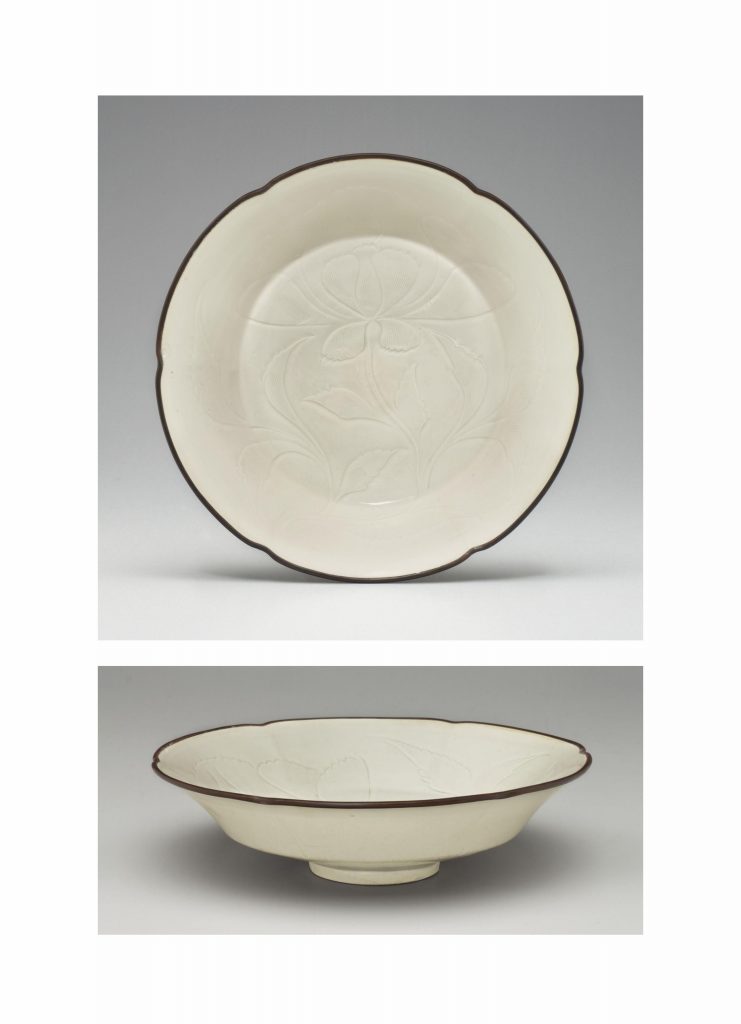
成交價 USD 147,750
估價 USD 20,000 – USD 30,000
北宋 定窰劃牡丹紋折沿葵口淺盌
來源
William B. Gruber Collection, acquired between 1957-1965.
参考:佳士得
19 9月 2013| 現場拍賣 2726
中國瓷器及工藝精品
拍品 1508
A QINGBAI CARVED DEEP CONICAL BOWL
THE PROPERTY OF A PRIVATE EUROPEAN COLLECTOR
南宋 青白釉牡丹紋笠式花口盌
SOUTHERN SONG DYNASTY, 13TH CENTURY
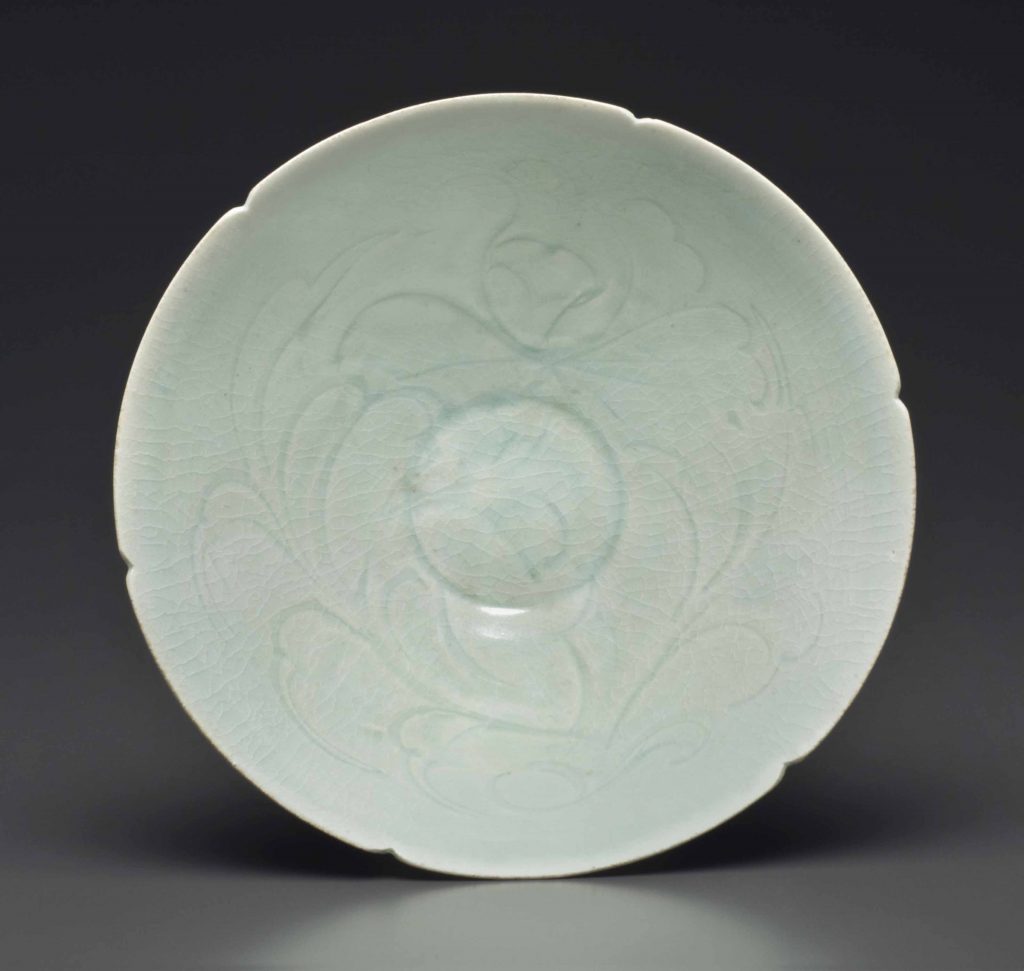
成交價 USD 11,875
估價 USD 6,000 – USD 8,000
來源
Eskenazi, London, no. A377.
By descent from the Reach Family Collection.
展覽
Eskenazi, London, Chinese Art from the Reach Family Collection, 8-22 December 1989, no. 28.
狀況報告
There is a speck of kiln grit and some expected light abrasion in the bottom of the interior. There are some minute glaze flakes and minute light fritting to the mouth rim. Bowl is in overall good condition and glaze of good color.
参考:佳士得
21 3月 2013 | 現場拍賣 2689
中國瓷器及工藝精品
拍品 1435
A DINGYAO CARVED CONICAL BOWL
北宋 定窰劃蓮紋葵口盌
NORTHERN SONG DYNASTY (960-1127)

成交價 USD 32,500
估價 USD 30,000 – USD 50,000
來源
Private family collection, Japan, acquired in the late Meiji/early Taisho period (1867-1925).
狀況報告
As can be seen in the illustration, the metal band that would have bound the mouth rim has been removed, and there is a russet-colored area of discoloration to the center of interior which is original to manufacture. The interior, mouth rim, and the notches have been polished, and there is a tiny chip to one notch.
拍品專文
Compare the foliate Dingyao bowl carved with a similar design on the interior, from the Qing Court collection, illustrated in The Complete Collection of Treasures of the Palace Museum – 32 – Porcelain of the Song Dynasty, Hong Kong, 1996, p. 60, no. 52.
参考:佳士得
26 11月 2013 | 現場拍賣 3266
英國里埃斯科珍藏重要中國瓷器
拍品 3101北宋/金 定窰刻萱草紋六棱盌
A DING CARVED ‘DAYLILY’ HEXAFOIL BOWL
NORTHERN SONG/JIN DYNASTY, 12TH-13TH CENTURY
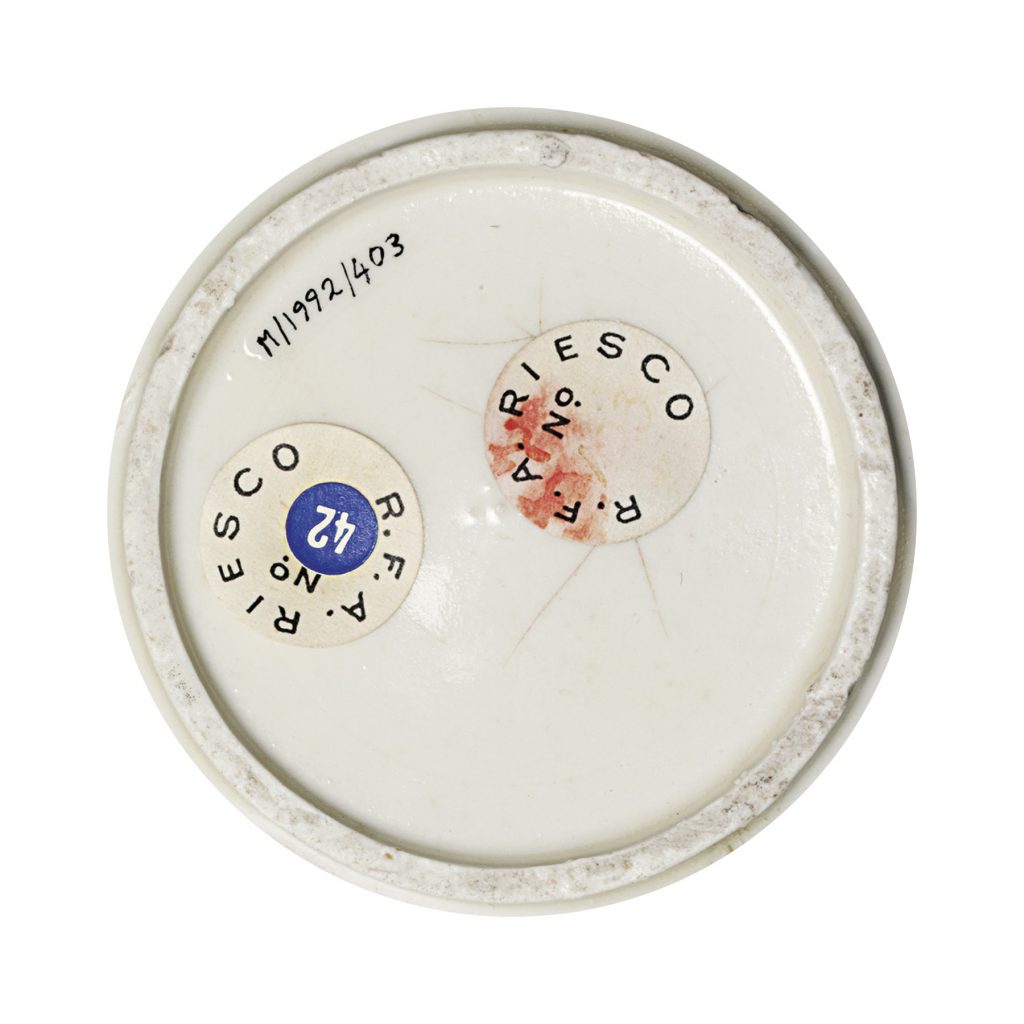
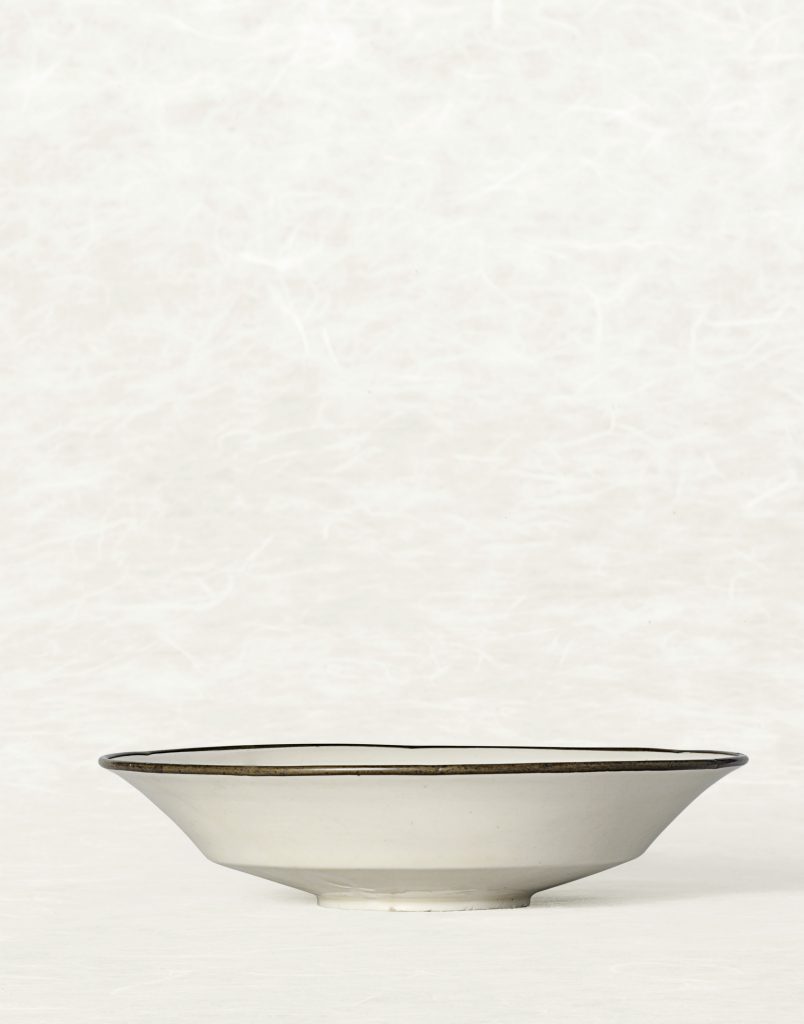
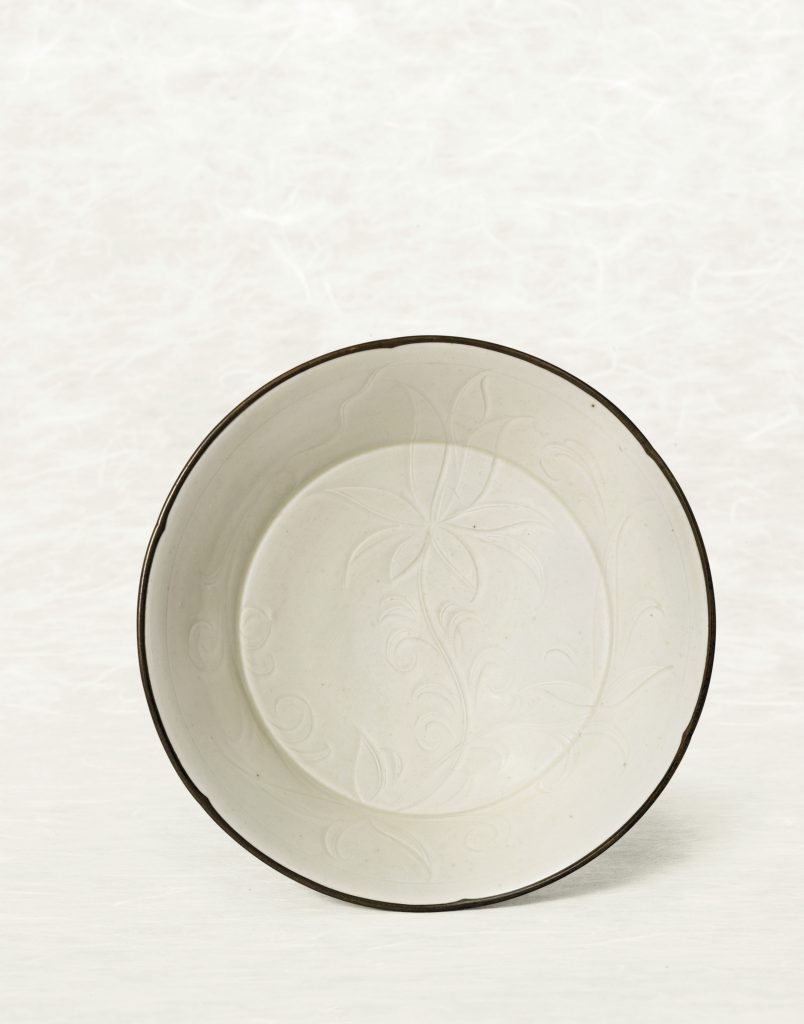
成交價HKD 1,600,000
估價HKD 1,500,000 – HKD 2,500,000
A Collector of Instinctive Good Taste Rosemary Scott, International Academic Director, Asian Art This season we are delighted to offer a select group of 24 Chinese ceramics from the collection of the British businessman and connoisseur Raymond F. A. Riesco (1877-1964) (fig. 1). Raymond Riesco’s father was from South America, while his mother was Scottish. Born in England, the eldest of four children, Raymond Riesco was christened Ramon Francesco Alfredo Riesco, but later, encouraged by his wife, he anglicised his given names to Raymond Francis Alfred, keeping only his surname in its original form. However, to his many friends he was ‘Jimmy’ Riesco. His early childhood was spent in South Norwood, in the south London borough of Croydon, although his South American father disliked the English climate and frequently worked abroad. At the age of fifteen Raymond Riesco began work in a small insurance office. He proved to be extremely able, and after a successful career in this small company, his employer introduced him to the much larger firm of Price Forbes in the City of London, suggesting that Riesco might run the firm. Eventually he did indeed run the firm with Mr. Forbes, until he retired. On 14 July 1914 Raymond Riesco married Ada Mary Hovenden (1886-1968), with whom he had three children – two daughters and a son. In 1925 Riesco bought ‘Heathfield’ (fig. 2) near Croydon. Both the house and grounds had been somewhat neglected but Riesco expended considerable funds and effort in restoring them, creating gardens that were greatly admired by visitors. There were terraces, a formal garden, a rock garden, a heather garden, and a rose garden, but one of Riesco’s greatest inspirations was to plant many mature trees, creating woods, as well as having rhododendrons and azaleas, whose flowers provided banks of brilliant colour in spring, while the large Chinese lilac on the lawn produced wonderfully fragrant pale mauve blossoms. The stables not only housed the Riesco children’s ponies, but were used by a family friend, Peter Thrale, for his racehorses. Riesco and his wife enjoyed entertaining and welcomed visitors from all over the world, including, as his daughter Jean has recorded, a Mr. Faberg?, son of the famous Russian court jeweller (Jean Thorpe, “Heathfield” Remembered 1925-65, 1984). During the Second World War about 20 members of staff from Riesco’s London office also moved into ‘Heathfield’ to escape the London bombings, and, although a flying bomb did hit the farm, no one was hurt. After Riesco retired in 1954 he took over the management of the farm, which was part of the estate, and ‘ran it as a model farm’. Riesco had many interests outside the insurance business. He and his wife enjoyed travelling – particularly to the United States, Canada and South Africa. His wife had a sister in Johannesburg, South Africa. They particularly enjoyed travelling by sea in the age of the grand ocean liners, and they were able to make voyages on Cunard’s Queen Mary, Aquatania, and Mauretania, and Norddeutscher Lloyd’s Bremen – sending back post cards and other mementos, which were put in albums by the family. Riesco was an acknowledged authority on philately, and also had a collection of watercolours and etchings. His collection of stamps was sold before the Second World War, but after 1935 he gave serious attention to the collection of Chinese ceramics. From 1951 to 1961 he served on the Council of the Oriental Ceramic Society, and he loaned pieces from his collection to various of the exhibitions held by the Society. Indeed he loaned three of the pieces in the current sale to the Society’s 1946 exhibition of Ming Blue-and- White Porcelain (Lots 3107, 3117 and 3119) – three further pieces belonging to Riesco were also included in this exhibition. Raymond Riesco was on the Exhibition Committee of the OCS Loan Exhibition of Chinese Blue and White Porcelain 14th to 19th Centuries, held in London in 1953-4, loaning 46 pieces from his own collection, including eight of the undeglaze blue decorated porcelains in the current sale (Lots 3105, 3107, 3108, 3111, 3113, 3116, 3117, and 3119). Riesco was also on the Exhibition Committee of the 1957 OCS Loan Exhibition of the Arts of the Ming, in which twelve of his own pieces were displayed, including six of the porcelains in the current sale (Lots 3114, 3117, 3118, 3119, 3121, and 3122). This was a very prestigious exhibition and his pieces were shown alongside those belonging to other great collectors such as H.M. the King of Sweden, Sir Percival and Lady David, and Mr. and Mrs. R.H.R. Palmer. After the Riesco collection was acquired by the London Borough of Croydon, four of the items in the current sale were loaned to the Oriental Ceramic Society’s major 1971 exhibition The Ceramic Art of China (Lots 3109, 3114, 3117, and 3121). Raymond Riesco was also a generous benefactor to the OCS, and initiated the setting up of the Society’s endowment fund. He also bequeathed a selection of Ming dynasty ceramics to the British Museum (see J. Harrison-Hall, Ming Ceramics in the British Museum, London, 2001, p. 594). The majority of the remaining pieces from Riesco’s Chinese ceramic collection were acquired by the London Borough of Croydon when the Council purchased Mr Riesco’s home, Heathfield House, and surrounding land in Addington, south London, following his death in 1964. Riesco appears to have made some of his first purchases of Chinese ceramics from the firm of Bluett & Sons in London at the end of the First World War, but it was not until after the International Exhibition of Chinese Art held in London in 1935 that he was inspired to form a significant collection. The archives of Bluett’s show that Riesco purchased more than 500 pieces from the company, and his last purchase from them was in 1961, only three years before his death (Dominic Jellinek, ‘Bluett Essay (Part 2), CARP). His daughter Jean Thorpe (n?e Riesco) recalls that although his collection of Chinese ceramics was not then as extensive as it would later become, some of the pieces were buried in the garden in packing cases during the Second World War to keep them safe (Jean Thorpe, “Heathfield” Remembered 1925-65, 1984). Riesco’s daughter Jean has also recalled that one of the first items of Chinese ceramics which her father bought was a Tang dynasty horse. When it arrived at their home, the children of the family were young enough to be disappointed that the horse had no tail. Raymond Riesco therefore went out into the paddock, cut some of the hair from the tail of their little Welsh pony ‘Taffy’ and attached these to the Tang horse. Today the Tang horse still has its ‘real’ tail, and is on display in the Riesco Gallery at Croydon Clocktower with other items from the Riesco collection (fig. 3). From 1935 Riesco set about assembling a fine collection of Chinese ceramics, concentrating on the porcelains of the Ming (1368-1644) and Qing (1644-1911) dynasties, but including pieces from the earlier periods (fig. 4 and fig. 5). He was described by one of his contemporaries as having instinctive good taste in his selection of Chinese ceramics. Each of Riesco’s purchases was meticulously recorded, in his own hand, in one of the three volumes which form an inventory of his collection. This hand-written inventory includes more than 740 entries – some of them pairs or sets – while the third volume records, in an appendix, a small number of Japanese ceramics. The scope of the collection, which ranges from the cold-painted earthenwares of the Neolithic period to the fine porcelains of the Qing dynasty, was described by Edgar Bluett in a series of three articles for the Antique Collector published in June, August and October 1951. These articles were later published in book form, entitled The Riesco Collection of Old Chinese Pottery and Porcelain, with additional illustrations. Although he evidently wished to construct a collection which would exemplify the historical development of Chinese ceramics, it is clear that Raymond Riesco had a personal preference for fine wares of the Song dynasty, and, most especially, porcelains of the Ming dynasty, as well as those from the reign periods of the three great Qing emperors – Kangxi, Yongzheng and Qianlong. While the ceramics in the current sale are predominantly porcelains from the Ming dynasty, smaller number of exceptional early wares are included. Three of these had been in important collections even before they were purchased by Riesco. The exquisite Song dynasty Ding ware dish with carved daylily decoration (Lot 3101) was in the collection of Alfred Schoenlicht – resident of New York and the Hague, whose fine collection was sold in London after his death in 1955; the impressive Jin-Yuan dynasty splashed Jun ware bowl (Lot 3103) was in the famous collection of William Cleverley Alexander (1840-1916) – a wealthy English banker with an extensive collection of art; and the rare lobed Guan ware bowl (Lot 3104) was in the collection of Alfred Chester Beatty (1875-1968), later Sir Alfred Chester Beatty, whose remaining collection is now in the Chester Beatty Library in Dublin. A large proportion of the Ming and Qing porcelains in the current sale also had illustrious histories before entering the Riesco collection. The vibrantly painted Yongle bowl (Lot 3106) and the rare Chenghua ‘boys’ bowl (Lot 3113), were both formerly in the collection of Archibald Dooley Brankston (1909-41), who was born in China, was involved in the preparations for the 1935 International Exhibition of Chinese Art, and succeeded Robert L. Hobson as Assistant Keeper in the Department of Oriental Antiquities at the British Museum. He was also the author of Early Ming Wares of Chingtechen, published in 1938, and the very rare lianzi bowl (Lot 3109) had also belonged to him, and was illustrated in his Early Ming Wares of Chingtechen, as plate 5a. The beautiful and rare Xuande (1426-35) double gourd-shaped vase (Lot 3111), was previously in the collection of the French Ambassador to Peking and that of John Frederick Woodthorpe (1897-1966), a Master of the Supreme Court, Chancery Division, who was also an active member of the Oriental Ceramic Society. The large finely-painted blue and white dish (Lot 3105) had belonged to the revered collector and scholar Sir Percival David (1892-1964), who was generally acknowledged to have the finest private collection of Chinese ceramics outside China. The unusually large Xuande ‘sugar loaf base’ or CY mantou xin bowl (Lot 3107) was formerly in the collection of Major Lindsay Fitzgerald Hay (1891-1946) – an officer in the Black Watch who was known for his exceptional height (6 feet 11 inches) and his collections of classic cars and Ming porcelain, while the rare Chenghua dish with lotus scrolls bearing the Eight Buddhist Emblems (Lot 3112) had been with Wu Lai-Hsi, a well-known dealer in Beijing in the 1930s. The striking Hongzhi ‘green dragon’ dish (Lot 3115) had been in the collection of George Eumorfopolous (1863-1939), a Greek tycoon, who was the first president of the Oriental Ceramic Society (1921-39), and whose Chinese ceramic collection was published in six folio volumes, catalogued by Robert L. Hobson (1872-1941). The fine Hongzhi dish with underglaze blue fruit and flowers against a yellow enamelled ground (Lot 3114), which Riesco photographed in his garden to get the full effect of the colours in natural light (fig. 6), had come from the collection of Francis Howard Paget (d. 1945), who was one of the lenders to the 1935 exhibition and bequeathed a number of rare Ming porcelains to the British Museum, while the Jiajing ‘phoenix’ dish in the same palette (Lot 3118) had been in the collection of Mrs. Brenda Z. Seligman (d. 1965), widow of Professor Charles G. Seligman (1873-1940) – they too were major lenders to the 1935 exhibition, and the pieces they acquired together and those acquired by Mrs. Seligman after her husband’s death were published in two volumes by John Ayers in 1964. The extremely rare Qing dynasty Kangxi mallet vase with underglaze copper red decoration (Lot 3123) is one of a pair that had been in the collection of Field Marshall Horatio Herbert Kitchener, 1st Earl Kitchener of Khartoum (1850-1916), much decorated military officer whose image was used on recruiting posters during the First World War, encouraging young men to enlist in the armed forces. The group of vessels in the current sale include many exceptional pieces, but is particularly rich in blue and white porcelains from a period which many connoisseurs regard as the Golden Age of Chinese blue and white – the 15th century. Among the highlights is a rare and elegant Xuande (1426-35) double gourd-shaped vase, which bears a six-character Xuande reign mark written horizontally around the upper bulb (Lot 3111). This vase reflects an especially successful melding of Chinese and Near Eastern inspiration, which was appreciated by wealthy patrons in countries to the west of China, and by the Chinese court of the early 15th century, as evidenced by the discovery of a fragment of a similar flask in the ruins of the early Ming dynasty imperial palace at Nanjing (illustrated in A Legacy of the Ming, Hong Kong, 1996, p. 48, no. 52). Another highlight from the Xuande reign period is the beautiful dish with a lotus scroll in the central roundel and exquisitely painted naturalistic fruiting sprays on the interior walls (Lot 3108). The delicate variegated lotus scroll on the interior of this dish is exceedingly rare, however an identical scroll can be seen on the interior of a slightly smaller, straight-rimmed, dish in the collection of the National Palace Museum, Taipei (illustrated in Catalogue of the Special Exhibition of Selected Hs?an-te Imperial Porcelains of the Ming Dynasty, Taipei, 1998, pp. 426-7, no. 186). A third important piece in this group is a bowl from the reign period traditionally lauded, alongside the Xuande reign, as producing the finest porcelains of the 15th century. This is the reign of the Chenghua Emperor (1465-87), and a particularly delightful bowl in the current sale is decorated with a scene of boy children playing in a garden (Lot 3113). As early as the Tang dynasty (AD 618-907) images of young boys at play was a popular secular theme on the Chinese decorative arts, being viewed as an auspicious symbol associated with the wish for sons and grandsons, and thus the continuation of the family line as well as the prosperity of the family. This decorative motif appears on rare, blue and white porcelain bowls of the Yongle reign (1403-24), such as that in the Tianminlou collection (Illustrated in Chinese Porcelain – The S.C. Ko Tianminlou Collection, Hong Kong, 1987, p. 43, no. 15), but in the Chenghua reign this decorative theme was particularly favoured by the Emperor, whose desire for an heir led to his commissioning items with auspicious wishes for sons and grandsons. The group of porcelains in this sale also includes outstanding items from the middle Ming period as well as very rare pieces from the Qing dynasty Kangxi reign. It is a measure of the quality of Raymond Riesco’s collection that, as well as appearing in exhibitions organised by the Oriental Ceramic Society, five of the pieces in the current sale were included in the prestigious Arte Cinese exhibition, Venezia, 1954 (Lots 3107, 3108, 3116, 3121, and 3122) and a number have been illustrated in seminal works on the subject of Chinese ceramics, such as Sir Harry Garner’s Oriental Blue and White, London, 1954 (Lots 3109. 3111, and 3116). The Riesco collection was assembled with great care by a man who seems to have had an instinct for exceptional Chinese ceramics.
拍品專文
細節
盌敞口,外撇腹,近足內折,平底微出邊,圈足。盌心淺刻一折枝萱草紋,枝葉伸繞內壁。鑲銅口。
此器造型規整,秀麗典雅,釉色均勻,白中帶牙黃。花卉紋線條簡潔有力,似是任意揮灑的作品,陶匠運刀尤如運筆寫意,加上定窰白釉特有的溫潤晶瑩,使紋飾更顯得典貴優雅。
本盌形制配合內劃萱草紋的例子並不多見,遼寧省博物館收藏一件稍小例子,紋飾構圖略有不同,載於1981年上海出版《中國陶瓷全集.9.定窰》,編號70。臺北故宮博物院收藏三件近似的劃萱草紋定窰盤,見1987年台北出版《定窯白瓷特展目錄》,圖版111-113號。日本臨宇山人收藏一件盌例,載於2012年香港出版《古韻天成:臨宇山人宋瓷珍藏展覽》,圖版4號。北京故宮博物院收藏二件缽例,載於1996年香港出版故宮博物院藏文物珍品全集《兩宋瓷器 .上》,圖版47、55 號。
此器源自Alfred Shoenlicht(卒於1955 年);1955 年12 月13日於倫敦蘇富比拍賣,拍品56 號;1955 年購自倫敦Bluett & Sons。曾借展予波士頓美術館。著錄於1987 年克羅伊登博物館出版《Riesco Collection of Chinese Ceramics Handlist》,編號42。
里埃斯科收藏編號103p。
來源
Alfred Shoenlicht (d. 1955)
Sold at Sotheby’s London, 13 December 1955, lot 56
Bluett & Sons, London, 1955
Raymond F.A. Riesco Collection, no. 103p
出版
天賦慧眼—收藏家里埃斯科
蘇玫瑰 亞洲藝術部資深學術顧問
本拍賣專集隆重呈獻英國企業家兼收藏家里埃斯科(1877-1964年)(圖一)舊藏之二十四件中國陶瓷。
里埃斯科出生於英國,父親為南美洲人,母親為蘇格蘭人,他於四名子女中居長。 里埃斯科在倫敦克羅伊登市以南的南諾伍德渡過童年,他的南美藉父親卻不甚習慣英國天氣,亦經常出差。里埃斯科年僅十五歲就開始在一間小型保險公司工作,他表現極佳,深得上司器重,後來更引薦他轉職倫敦的大型保險公司Price Forbes,提議由他執掌業務。結果他與創辦人共同管理公司,直至退休為止。1914年7月14日里埃斯科與Ada Mary Hovenden(1886-1968年)結婚,婚後育有二女一子。 1925年里埃斯科購入克羅伊登附近赫思費特之大宅(圖二),原來的房屋及花園頗為荒廢。他不惜斥資修建,設計出美侖美奐的花園,而大獲訪客好評。大宅落成包括露台、傳統花園、賞石花園、石楠花園、玫瑰花園。而他最大的心思在於庭園中廣植大樹成林;還遍植杜鵑,好等春天盛放燦爛;以及在草坪上種滿大朵紫丁香,形成一片幽香淡紫的花海。至於所置馬廄不單養畜兒女的小馬,同時提供世交Peter Thrale安置賽馬。里埃斯科夫婦非常好客,經常招待來自世界各地的訪客,他們的女兒Jean就記錄了俄羅斯皇室珠寶商法貝熱之兒子到訪(1984年出版Jean Thorpe著《“Heathfield” Remembered 1925-65》)。二次世界大戰期間里埃斯科的倫敦辦公室約20名職員曾暫居赫思費特大宅,以逃避倫敦的砲火,該宅雖遭轟炸,只命中農場,無人受傷。1954年里埃斯科退休後,他專心管理大宅附屬的農場,打造出「模範農場」。
里埃斯科除保險事業外,並有不少嗜好。夫婦二人經常出門旅行,尤其到美國、加拿大、南非,里埃斯科夫人有姊妹居於南非約翰內斯堡。他們特別喜歡從海路出發,當時流行遠洋遊輪,他們乘搭過冠達郵輪旗下的瑪麗皇后號、阿奎坦尼亞號、茅利塔尼亞號,以及北德意志羅伊德郵輪旗下的不來梅號。他們從郵輪上寄回明信片及其他小紀念品,均存放於家庭相簿。里埃斯科亦是著名的集郵專家,並收藏水彩畫及蝕刻畫。他的郵票珍藏於二次世界大戰以前已出售。自1935年起他專注收藏中國陶瓷,1951至1961年間並列席東方陶瓷學會委員會,期間借出藏品予該會多次展覽。
本專集中三件拍品就曾展出於1946年舉辦展覽《Ming Blue-and-White Porcelain》(拍品3107、3117、3119),參展的還有他的另外三件藏品。1953-54年舉辦的展覽《Loan Exhibition of Chinese Blue and White Porcelain 14th to 19th Centuries》,他亦是籌備委員,並以四十六件藏品參展,包括這次拍賣的八件青花瓷(拍品3105、3107、3108、3111、3113、3116、3117、3119)。1957年舉辦的展覽《Loan Exhibition of the Arts of the Ming》,他再次出任展覽委員,並以十二件藏品參展,其中六件於本次拍賣(拍品3114、3117、3118、3119、3121、3122);至於該參展者均是顯赫的收藏家,包括瑞典國王、倫敦大維德爵士、帕爾默伉儷。自里埃斯科藏品轉贈克羅伊登市後,其中四件又參展了1971年舉辦的大型展覽《The Ceramic Art of China》,它們亦於本次拍賣(拍品3109、3114、3117、3121)。 里埃斯科亦是東方陶瓷學會的慷慨捐助人,更發起成立學會捐贈基金。他並將一系列明瓷贈予大英博物館(2001年倫敦出版 J. Harrison-Hall著《Ming Ceramics in the British Museum》,594頁)。
1964年他逝世後,倫敦克羅伊登市議會買下里埃斯科家族赫思費特大宅,以及相連的倫敦南部阿丁頓地皮,他餘下的中國陶瓷藏品大部份亦收歸克羅伊登市名下。 第一次世界大戰結束時,里埃斯科從倫敦Bluett & Sons購藏最早的藏品,但直至1935年舉辦的《倫敦中國藝術國際展覽會》,才啟發他認真收藏中國瓷器。根據Bluett & Sons的銷售檔案,里埃斯科曾於該古董商購買逾500件物品,最後一次為他逝世前三年之1961年(CARP出版Dominic Jellinek著作「Bluett Essay(Part 2)」)。他的女兒Jean憶述當時父親的中+國陶瓷收藏遠不及後來的豐富,其中一些於二次大戰期間曾裝箱埋在花園,以保安全(《“Heathfield” Remembered 1925-65》)。她並記得父親最早的中國陶瓷藏品中有一件唐三彩馬,年幼的子女看到它缺了尾巴而大失所望,里埃斯科遂走進馬廄,剪下家中威爾斯種小馬的尾毛,插於唐三彩馬。今天該馬還留著這條馬尾毛,現收藏於克羅伊登鐘樓里埃斯科展覽廳,與其他藏品一起展出(圖三)。
自1935年起里埃斯科開始建立他的中國陶瓷珍藏,集中搜集明清瓷器,亦著眼於較早朝代的珍品(圖四︑五),贏得一位同輩讚許他對中國陶瓷獨具慧眼。里埃斯科對每件購藏物品皆手書詳細記錄,集結成三冊收藏目錄。這些收藏記錄逾740項,其中一些為成對或成組藏品,而第三冊的附錄註有少量日本陶瓷。他的陶瓷藏品起自新石器時代陶器,直至清瓷精品,1951年出版的《Antique Collector》六月、八月、十月號就刊載了Edgar Bluett介紹這批藏品的三篇文章,後來更結集成書《The Riesco Collection of Old Chinese Pottery and Porcelain》,並增訂插圖。很明顯里埃斯科希望建立一個完整系列的藏品,以代表中國陶瓷的發展史,然而他個人還是偏愛宋瓷珍品,尤好明瓷,以及清康雍乾三朝精品。 此次拍賣包羅的大部份為明瓷,亦有三件較早年代的珍品,它們在里埃斯科收藏以前,來源非常顯赫。
宋代定窰刻花盌(拍品3101)為紐約及海牙收藏家Alfred Schoenlicht舊藏,1955年他逝世後其珍藏在倫敦拍賣。
金/元鈞窰紫斑盌(拍品3103)為英國銀行家William Cleverley Alexander(1840-1916年)舊藏,他以藝術藏品豐富而聞名。珍罕的官用青瓷盌(拍品3104)為Alfred Chester Beatty(1875-1968年)舊藏,他後來獲封爵士,的其他藏品現收歸愛爾蘭都柏林切斯特比特圖書館。 這次拍品中大部份明清瓷器在里埃斯科收藏以前已有著錄。
永樂青花纏枝花卉紋盌(拍品3106)、成化青花嬰戲圖盌(拍品3113)均源自Archibald Dooley Brankston(1909-1941年)舊藏。他在中國出生,曾參與籌備1935年舉辦的《倫敦中國藝術國際展覽會》。他後來繼任Robert L. Hobson成為大英博物館東方文物部助理館長,並於1938年出版著作《Early Ming Wares of Chingtechen》,這次珍罕的宣德青花蓮子盌(拍品3109)亦是他的舊藏,並載於著作中,圖版5a。
瑰奇的宣德青花葫蘆式扁瓶(拍品3111)先後為法國駐北京大使、JohnFrederick Woodthorpe(1897-1966年)收藏。John Frederick Woodthorpe是大法官署的主事官,他活躍於東方陶瓷學會。
永樂青花折沿大盤(拍品3105)原屬著名的博學收藏家大維德爵士所有,他的藏品獲譽為中國以外最佳的私人收藏。
罕見的大型宣德饅頭心盌(拍品3107)源自英國少校 Lindsay Fitzgerald Hay(1891-1946年)舊藏,他任職英國陸軍之高地兵團,身高6呎11吋,以收藏古董汽車及明瓷見稱。珍罕的成化青花蓮托八寶紋盤(拍品3112)來自1930年代北京著名古董商吳賚熙。
雅緻的弘治綠彩雲龍紋盤(拍品3115)曾為希臘大亨George Eumorfopolous(1863-1939年)收藏,他是東方陶瓷學會的首任會長(任期1921-1939年)。他的中國陶瓷收藏結集成六冊巨著,由Robert L. Hobson(1872-1941年)編纂。
精美的弘治黃地青花梔子花紋盤(拍品3114)曾讓里埃斯科放到花園中拍照(圖六),以採得最好的自然光度,它源自Francis Howard Paget(卒於1945年)舊藏,他曾參與1935年《倫敦中國藝術國際展覽會》,並捐贈一些珍貴的明瓷予大英博物館。
同樣為黃地青花紋飾的嘉靖穿花鳳紋盤(拍品3118)曾為Charles G. Seligman(1873-1940年)教授之夫人Brenda Z.(卒於1965年)收藏,Seligman伉儷是倫敦1935年舉辦中國藝術展覽的主要參展者,他們二人共同購藏、Brenda Z.後來購入的藏品,均著錄於1964年出版John Ayers所編二冊圖錄。
罕有的康熙釉裏紅夔鳳紋雙陸尊(拍品3123)原為一對,這件源自英國元帥Horatio Herbert Kitchener(1850-1916年)舊藏,他後來獲封第一代喀土穆伯爵,豐功偉績廣受歌頌,第一次世界大戰時其肖像更印成召募軍兵海報。 此次拍品中不乏稀世珍品,以明十五世紀青花瓷最多,那是無數鑑藏家視為中國青花瓷的黃金時代。
經典之一的宣德葫蘆式扁瓶(拍品3111),鼓圓上部口沿書六字橫款,它巧妙地融合中國與中東的風格,不但備受西域諸國貴冑的珍賞,更獲明十五世紀初宮廷的垂青,南京皇城遺址曾出土同款器物的瓷片,足以佐證(1996年香港出版《朱明遺萃:南京明故宮出土陶瓷》,48頁,編號52)。
另一件珍品為宣德青花纏枝蓮瑞果紋盤(拍品3108),盤心飾不同造型的蓮紋相間,內壁繪寫實折枝果紋,屬鳳毛麟角的例子,惟見臺北故宮博物院收藏一件稍小而直沿的近似例子,其盤心蓮紋與本盤相若(1998年台北出版《明代宣德官窯菁華特展圖錄》,426-427頁,圖版186號)。
第三件是成化青花庭園嬰戲圖盌(拍品3113),傳統上成化與宣德同譽為明青花瓷的經典時期,早於唐代中國裝飾藝術已出現嬰戲圖,紋飾象徵兒孫滿堂、家族興旺的祝願,參考天民樓收藏一件罕有的永樂青花嬰戲圖盌(1987年香港出版《天民樓藏瓷.上》,圖版15)。至成化皇帝因殷切祇求子嗣,下命製造大量多子紋飾的工藝品。 其他拍品包括明中葉、清康熙的精品。里埃斯科獨具慧眼所購藏的名瓷,除多次參展東方陶瓷學會展覽外,
其中五件曾展出於威尼斯1954年舉辦展覽《Arte Cinese》(拍品3107、3108、3116、3121、3122),以及著錄於中國陶瓷重要著作,例如1954年倫敦出版Harry Garner著《Oriental Blue and White》(拍品3109、3111、3116)。此次拍賣的里埃斯科珍藏,無疑展現出一位資深收藏家對中國陶瓷孜孜以求的心血。
展覽
On loan at the Museum of Fine Arts, Boston, prior to 1955
狀況報告
– There are two small star cracks to the underside of the base, one of which can be seen from the interior of the dish.
– There is one minute shallow chip to the inner mouth rim and a few minute nicks to the foot rim.
– Some general surface scratches and wear as expected from use and age.
拍品專文
The present bowl is a classic example of the finest Ding wares of the 12th-13th century. The form, almost certainly derived from metalwork, is one that provided a significant test for its potter particularly when combined with carved decorations. In order to achieve the sharp junction between base and sides, the thrown dish had to be placed over a wooden form and pressed down to achieve the sharp junction between base and sides. This process was rendered more difficult because the decoration had already been carved into the interior of the dish and risked being squashed in the forming process. It is a measure of the potter’s skill that the decoration remains crisp and distinct, and the current bowl stands as a testimony to such artistry, demonstrating a synergy of elegant form and fluid design.
Daylily blossoms was a popular motif on Ding wares from mid-Northern Song to Jin periods, and can be found on other open forms such as shallow dishes, conical bowls and deep bowls. Compare to a similar shallow bowl carved with the same motif, but bearing slight variation in composition, in the Liaoning Provincial Museum, and illustrated in Zhongguo taoci quanji – 9 – Dingyao, Shanghai renmin meishu chubanshe, 1981, no. 70. For the same carved motif on other forms, compare to three shallow dishes in the National Palace Museum, Taipei, illustrated in Catalogue of the Special Exhibition of Ting Ware White Porcelain, Taipei, 1987, nos. 111-113; a conical bowl included in the catalogue of The Classic Age of Chinese Ceramics: An Exhibition of Song Treasures from the Linyushanren Collection, Hong Kong, 2012, no. 4; and two deep bowls in the Palace Museum, Beijing, illustrated in Porcelain of the Song Dynasty (I), The Complete Collection of Treasures of the Palace Museum, Hong Kong, 1996, nos. 47 and 55. Other motifs carved on bowls of this form include ducks in lotus pond, such as an example illustrated by G. Hasebe in Sekai Toji Zenshu – 12 – Song, Tokyo, 1977, pl. 143, and a peony spray, as shown on a bowl sold at Christie’s New York, 22 March 2013, lot 1441.
参考:
北京保利2021春季拍卖会
佞宋——十面灵璧山居暨诸名藏古陶瓷清翫
5206 明 白釉划花莲花纹折腰盘

拍品信息
尺寸 直径20.7cm
估价 2,000,000-2,500,000
成交价 RMB 2,760,000
此件拍品为保税状态。
备注:
1. Frederick T. Fuller 收藏,至1965年
2. 伦敦佳士得1965年6月28/29日,编号277(1000 gns.)
3. Bluett & Sons Ltd,伦敦,1965年(1000 gns.)
4. 罗杰琵金顿(1928-69年)收藏, 自1965年
类北宋定窑风格白釉刻划萱草纹折腰盘,拍品撇口浅壁,折腰锐收,底宽平微凹下,下承小矮圈足,为定窑之经典器型。通体满施白釉,色如象牙,盘内壁与盘心采用刻划花技法饰萱草纹。匠艺运刀如画,刀笔流畅,斜刀带出宽的积釉面,寥寥几笔便成就一幅似在随风而动的萱草,十分了得。此盘外壁光素,施釉均匀,带垂釉泪痕,莹润悦目。此器口沿芒口覆烧,后配金属口。
定窑素以胎体细薄纯白和工艺精湛高超而闻名,其一胎体细白不施化妆土,窑烧后便可呈白净雅致之色,其釉光润,与象牙类,积釉流淌处可见“泪痕”,更因其器形含蓄温雅而备享赞誉。其二工艺精湛高超,本品的萱草纹饰,线条委婉而舒畅,优雅之神韵跃然其上,如纸上作画,笔墨韵味全然其间,同时倍显胎体之素净清丽。虽部分器形乃仿当朝银与漆,但更多为瓷匠创作,别具新意,深受北宋与金朝之皇室及佛寺钟睐,本例即属后者。定瓷胎体轻薄易碎,成形及窑烧过程极易变形翘棱,故此类盘直径多不超过22公分,仅些许宽盆及模印浅盘见有制大器,但其胎体亦相应偏厚较重,此器胎体轻薄,器型规整大气,实属不易。
同纹饰可参考一例类定窑风格的白釉划萱草纹香盒,为子爵松平家族珍藏,购于1910 年,后售于香港佳士得2014年秋拍编号2924,成交价184万港币;另一只与同器型折腰盘为英国里埃斯科珍藏重要中国瓷器,后售于香港佳士得,2013年秋季拍卖会,编号3101,成交价160万HKD。
本品早年为Frederick T. Fuller收藏,至1965年,后于伦敦佳士得1965年6月28/29日释出,拍品编号277(1000 gns.),被 Bluett & Sons Ltd收藏,伦敦,1965年(1000 gns.),后罗杰琵金顿(1928-69年)收藏, 自1965年。
参考:
北京保利2021春季拍卖会
佞宋——十面灵璧山居暨诸名藏古陶瓷清翫
5218 明 白釉模印并蒂莲六出花口碗

拍品信息
尺寸 直径18cm
估价 500,000-800,000
成交价 RMB —
备注:
日本重要私人藏家旧藏
类北宋至金代定窑风格白釉模印并蒂莲六出花口碗,此碗一枝同生的两朵莲花映映相对,旁饰有荷叶缠绕,风姿绰约,莲蓬初成,花香正浓,另有含苞待放者,一气呵成,不见滞涩,花卉纹饰清晰流畅,布局饱满大气,花叶轮廓线以增强立体感,给人以“濯清流而不妖,出污泥而不染”的清新美感。此器古朴雅致,敞口有芒,采用覆烧工艺,斜腹内收,浅圈足;内外施白釉,釉色白里闪黄,釉水凝聚处多呈牙黄色,表面釉光莹润。胎质细腻,胎色洁白,胎体有油腻感。碗心之双鱼划刻洒脱,生动形象。
北宋至金代年间,定窑佳器屡出,不仅获两朝宫廷垂青,最近研究发现定窑器皿甚至见于杭州南宋宫廷。定窑白瓷胎体细薄体洁白、釉色透亮略显乳白,饰纹素丽,沉静典雅,气韵非凡。根据传世定窑器及出土残片上之字款,可证定瓷曾为宫廷御器。工匠于瓷坯上刻字款,如“官”、“新官”、“尚食局”、“尚药局”等。另亦发现许多作例,经入窑烧后才刻上字款,如“德寿”、“德寿院”,即宋高宗内襌后迁居之德寿宫;“奉华”底款,即宋代皇帝贵妃所居之 奉华殿,还有“皇太后殿”、“东宫”等款,见《定瓷雅集•故宫博物院珍藏及出土定蜜瓷器荟萃》,北京,2012 年,各页。亦载于胡云法及金志伟,《中国古代白瓷国 际学术研讨会论文集,上海, 2005年,页285-300,图版 152-232。另见小林仁,《定窑: 优雅なる白の世界,窑址発掘成果展》,大阪市立东洋陶瓷美术馆,大阪,2013 年,页218-242。
本品集并蒂莲之瑞意,撷造型之隽美,犹为可珍。并蒂莲属荷花中的千瓣莲类,是花中珍品,集莲荷之精华于一身,尤能引人入胜。自古以来,视之为吉祥、喜庆的征兆,善良、美丽的化身。据《群芳谱》卷二十九:并头莲,晋泰和间生于玄圃,谓之嘉莲。另见《全芳备祖》后集•莲部记载:泰始二年,嘉莲双葩,并实、合跗、同茎。明人林承芳赞之艳若凤翎,晖若龙烛。色震百草,艳绝群英。
模印并蒂莲的题材极为罕见,我们可参考同样是莲花题材的例子,如此件北宋定窑白釉划莲纹葵口大碗,此例为日本细川家族珍藏壶中居,东京临宇山人珍藏,于2016年5月30日售于香港佳士得,成交价为748万HKD。另一件北宋定窑刻莲花纹盌,于2013年3月9日售于纽约苏富比,成交价为17,25万HKD。
参考:佳士得 25 11月 2018 | 現場拍賣 17461
不凡- 宋代美學一千年 (晚間拍賣)
拍品 8005
A FINE DING CARVED ‘LOTUS’ HEXAFOIL BOWL 3 更多
THE PROPERTY OF A GENTLEMAN
北宋 定窯刻蓮紋花口盌
NORTHERN SONG DYNASTY (960-1127)
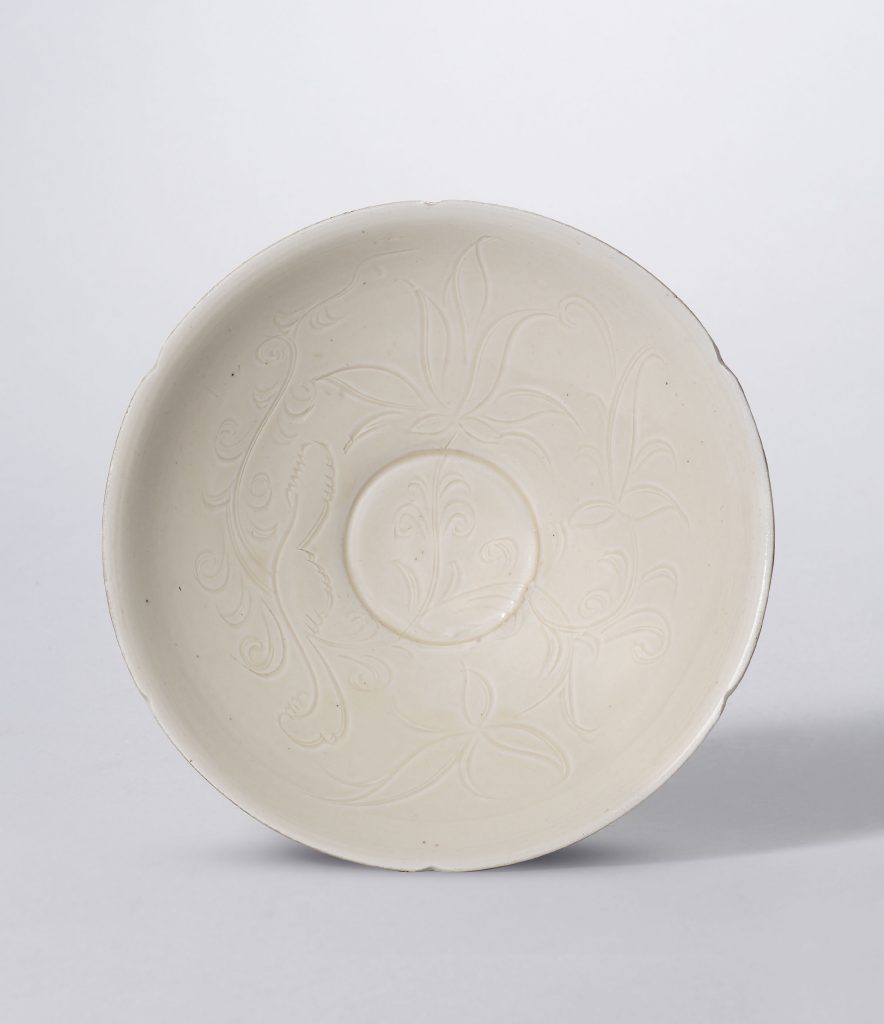
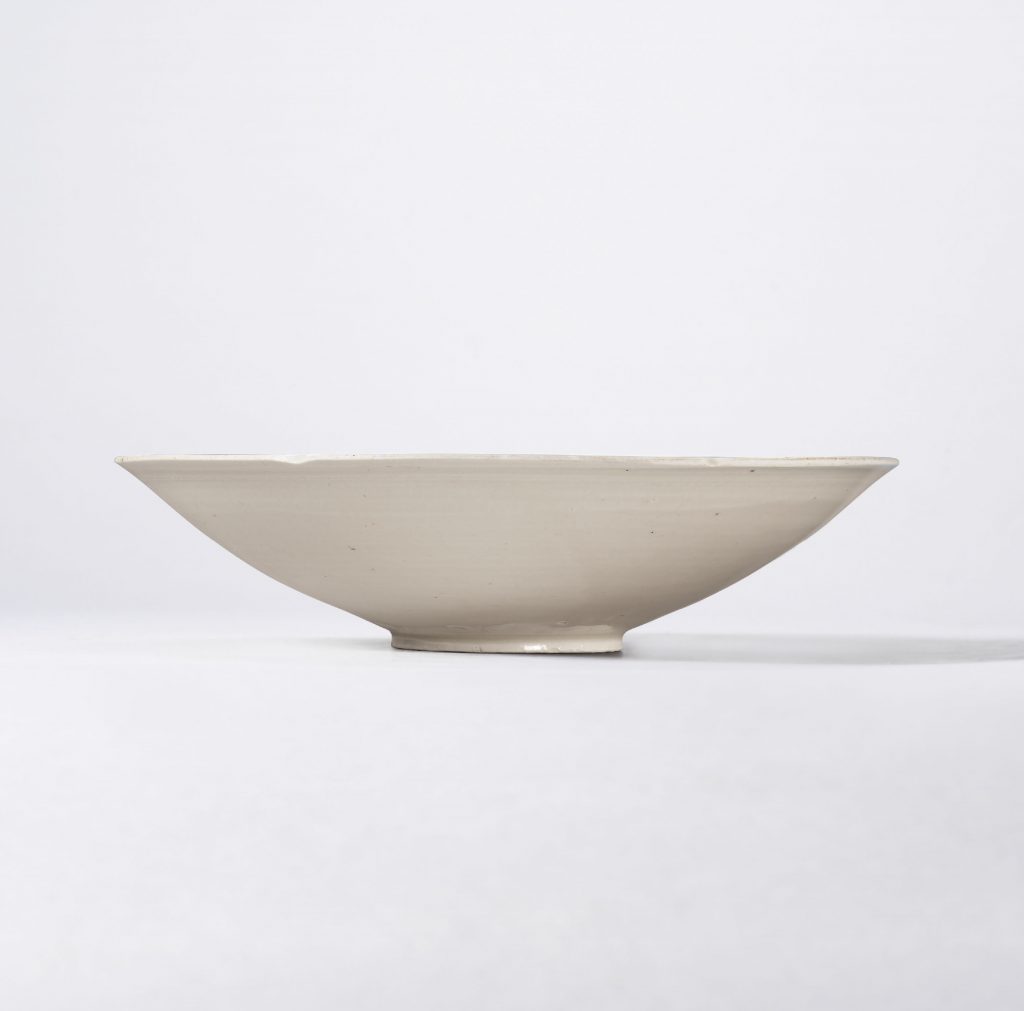
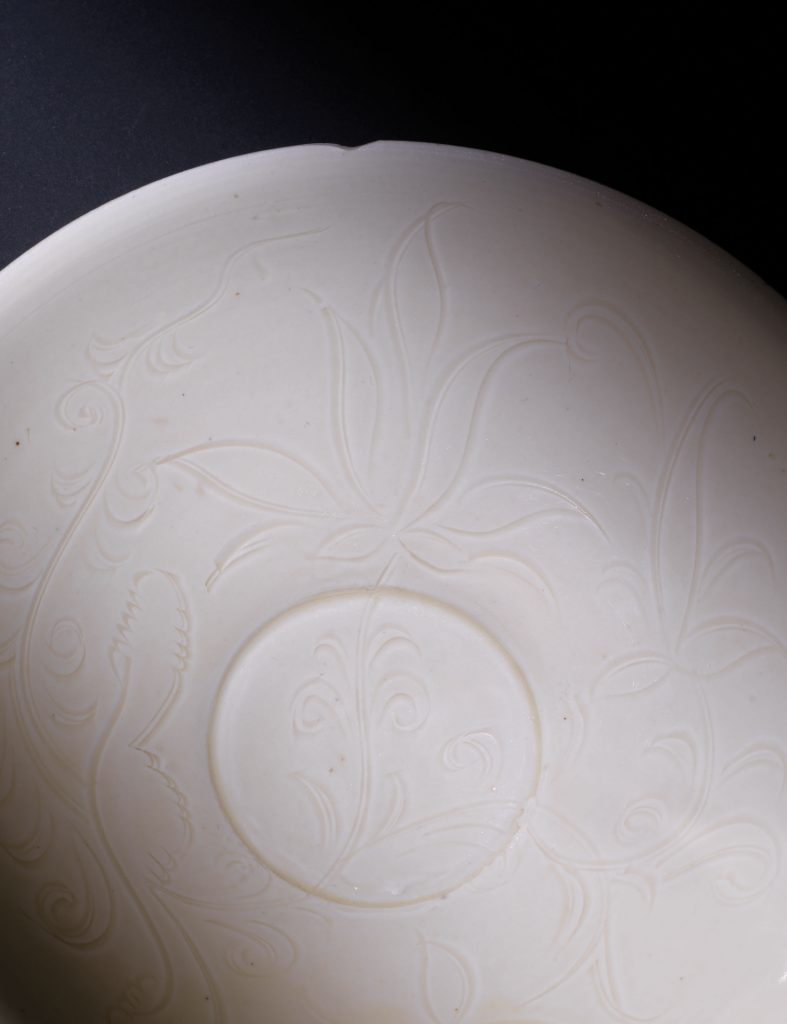
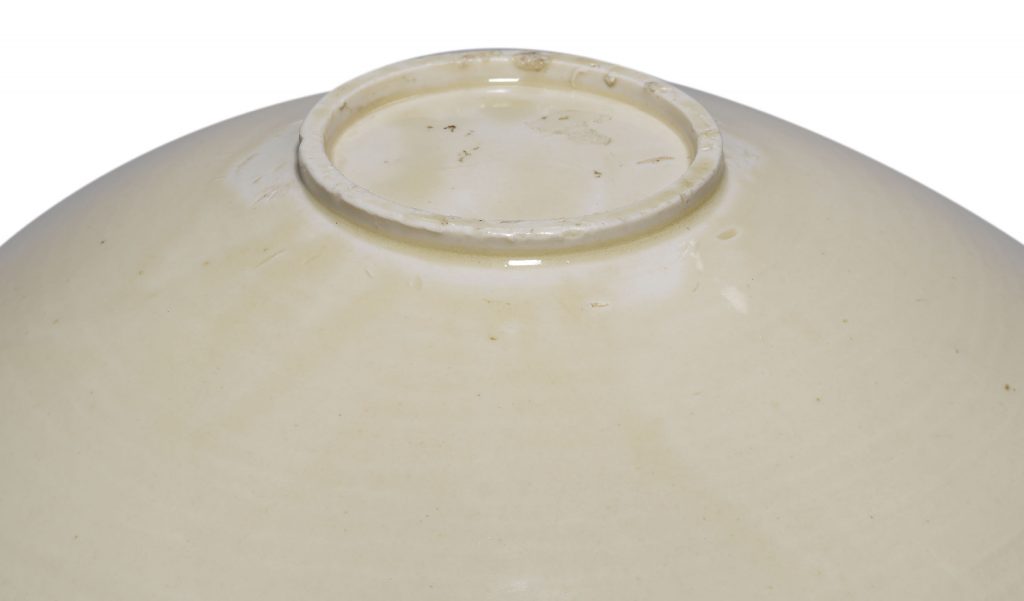
成交價 HKD 1,750,000
估價 HKD 1,200,000 – HKD 1,800,000
北宋 定窯刻蓮紋花口盌
NORTHERN SONG DYNASTY (960-1127)
細節
北宋 定窯刻蓮紋花口盌
盌敞口,六瓣式,淺弧腹,矮圈足。內壁刻三株長莖彎繞的蓮花及一片伸張蓮葉,內底平凹,外壁光素。通體施素雅象牙白釉,口沿露胎處呈現堅細白瓷胎。
7 3/4 in. (19.7 cm.) diam., box
來源
2000 年6 月12 日購自倫敦埃斯肯納齊
西方私人珍藏
倫敦邦瀚斯,2013 年5 月16 日,拍品7 號
狀況報告
-整體品相非常良好,惟外足沿有兩個非常小的淺磕,各約0.2公分
-口沿有數個微磕,於燒製時產生
拍品專文
潞公煎茶學西蜀,定州花瓷琢紅玉
-《試院煎茶》,蘇軾,熙寧五年(1072)
以上詩句節錄自《試院煎茶》,是北宋文豪蘇軾在熙寧五年當杭州通判時寫下的雜言古詩。裡面提到同僚文彥博(北宋宰相,著《文潞公集》)以西蜀古法煎茶,茶湯撞上有花紋的定窯白瓷,湯色泛紅,視覺效果有如經雕琢的紅玉。這兩句雖從沒提到「白」字,卻活靈活現地道出定窯瓷的晶瑩白潤,以及定窯器在當時為風雅文人所喜用的茶具。有趣的是,約二十年以後,在元祐八年(1093),蘇軾受命出知定州,可見蘇軾與定窯瓷有著不解之緣。其《定州謝到任表》裡的幾句「臣敢不勤恤民勞,密修邊備。茍無大過,以及期年。漸還魚鳥之鄉,以畢桑榆之景」,更透露出這位心繫家國的文人,兢兢業業地經營定州政務的心境。蘇軾以後,「定州花瓷」一語廣為文人所用,例如金人劉祁(1203-1259)《歸潛志》裡記「定州花瓷甌,顏色天下白」,可見時至金代晚期,有花紋的定窯白瓷依然深為文士所稱頌,並造就定窯瓷在後世歷久不衰的地位。
本盌器形雋雅靜謐,胎骨細白,釉光澄淨潤澤,刀工嫻熟流暢,為「定州花瓷」中之精品。可比較一件紋飾、器形幾乎一致的例子,為Oppenheim 舊藏,現藏大英博物館,著錄於《The World’s Great Collections: Oriental Ceramics》,卷5,圖版20 號。另一相似例曾著錄於1987 年東京出版《中國陶磁:出光美術館藏品圖錄》,後在2009 年12 月1 日於香港佳士得拍賣,拍品1863 號。亦有一件器形及尺寸相若例子,惟盌內蓮紋風格迴異,藏北京故宮博物院,著錄於《中國陶瓷全集 – 定窯》,上海,1981 年,圖版90 號。Alfred Clark 夫人及戴潤齋曾先後遞藏一件器形相似的定窯盌,盌內花紋略異,於2011 年3 月22 日紐約蘇富比拍賣,拍品167 號。
参考:故宫博物院
【定窑白釉印花菊凤纹盘】


定窑白釉印花菊凤纹盘,宋,高4.3厘米,口径19.2厘米,足径12.7厘米。
盘敞口,坦底,弧壁,圈足,口沿露胎无釉处镶铜口。通体施白釉,釉色白中泛灰,外壁明显见到拉坯留下的旋痕以及蘸釉时留下的“泪痕”状垂釉。器里口沿模印回纹一周,内壁模印荷花纹饰,盘心模印双凤菊花图案。外底镌刻清代乾隆皇帝御题诗一首。诗曰:
古香古色雅宜心,宋定名陶器足珍。
质韫珠光堪作鉴,纹镂花鸟具传神。
擎来掌上掬明月,题向诗中证旧因。
盛得朱樱千万颗,满盘琥珀为生辉。
后署“孟春御题”。钤“比德”、“朗润”两方章。
此件定窑白瓷盘上刚劲有力的图案线条、层次分明的构图以及以缂丝图案为摹本的凤穿花纹样,均在暖白色釉层的掩映下相得益彰。此盘在传世宋代定窑器物中虽非精品,如白色釉面中有黑色杂质,修足也不甚规矩,但从乾隆皇帝题诗之举也足以证明当年定窑器物在宫中受宠的情形。此盘曾一度流出宫外,20世纪50年代由国家文物局购回并拨交故宫博物院收藏。
定州在北宋时是商贾云集的商业重镇,这里不但生产瓷器也铸造金银器,同时还是丝织物的集散地。在这种大环境下,定窑工匠们自然会将金银器的模造技法和丝织物的图案与白瓷的烧造技术结合在一起。所以定窑白瓷上的印花装饰,一开始就显得比较成熟,具有很高的艺术水平。
撰稿人:刘伟
关键词: 定窑 印花 泪痕 垂釉 模印 回纹 白瓷 缂丝
参考:佳士得
6 Nov 2006 Live Auction 7270
Fine Chinese Ceramics and Works of Art Including Export Art
Lot 149 宋 定窑模印碗
A DINGYAO MOULDED BOWL
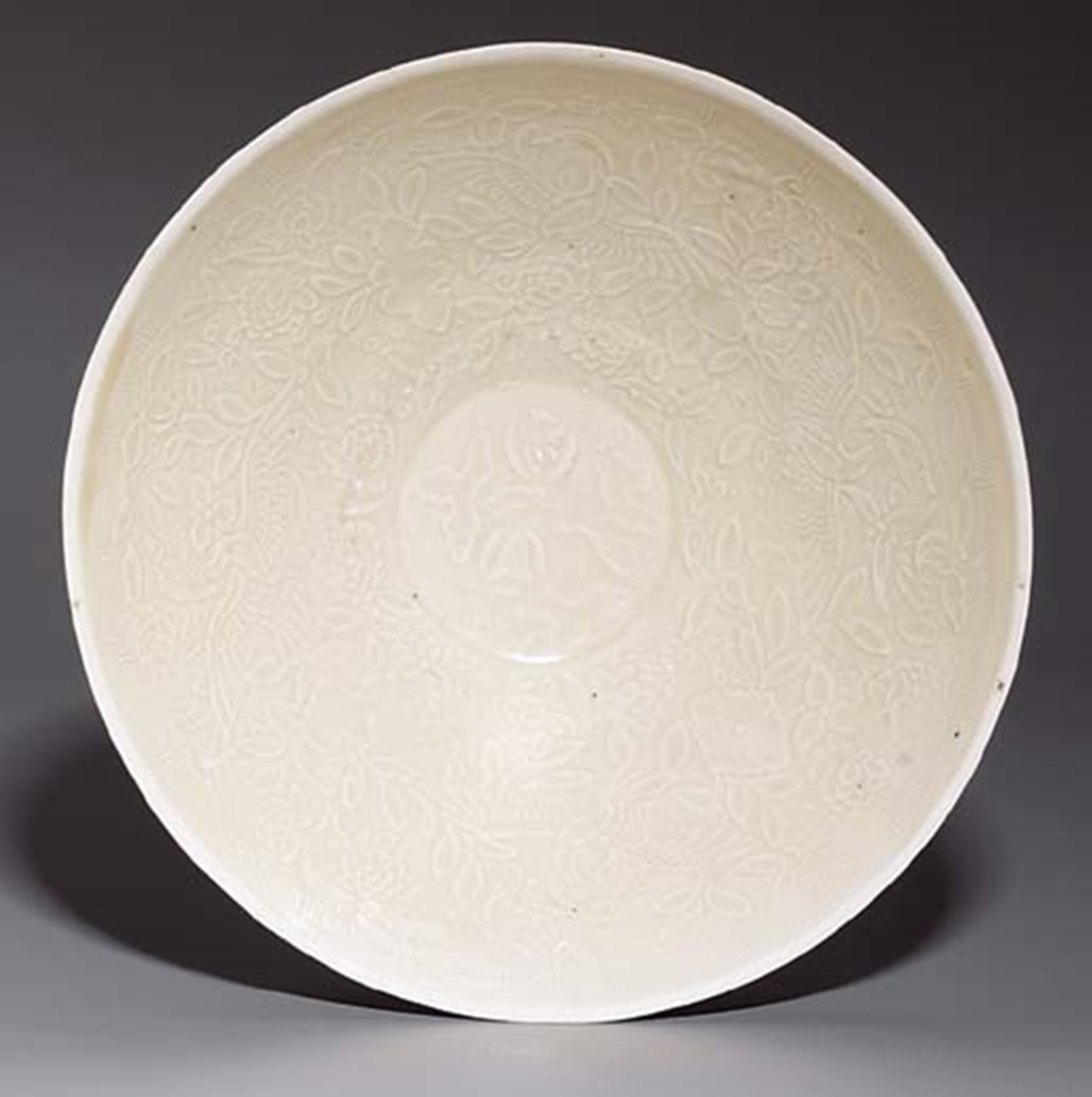
Special Notice
A DINGYAO MOULDED BOWL
NORTHERN SONG DYNASTY (960-1127)
Price realised GBP 3,000
Estimate GBP 3,000 – GBP 5,000
A DINGYAO MOULDED BOWL
NORTHERN SONG DYNASTY (960-1127)
A DINGYAO MOULDED BOWL
NORTHERN SONG DYNASTY (960-1127)
With shallow rounded sides rising from a straight, neatly cut foot, the interior crisply moulded with four pheasants in flight amongst lotus and other aquatic plant life, below a band of key-fret pattern, covered overall in an even ivory glaze
7 5/8 in. (19.4 cm.) diam.

![[临渊阁]天地一家春](https://www.antiquekeeper.ca/wp-content/uploads/2023/03/antiquekeeper_banner_image_2-4.jpg)
